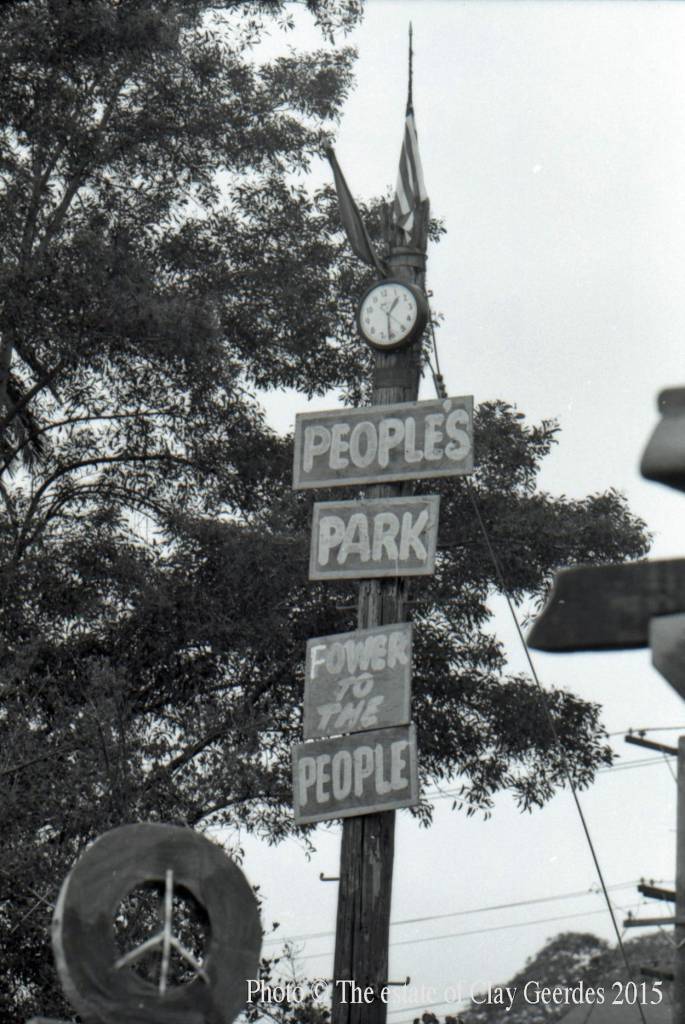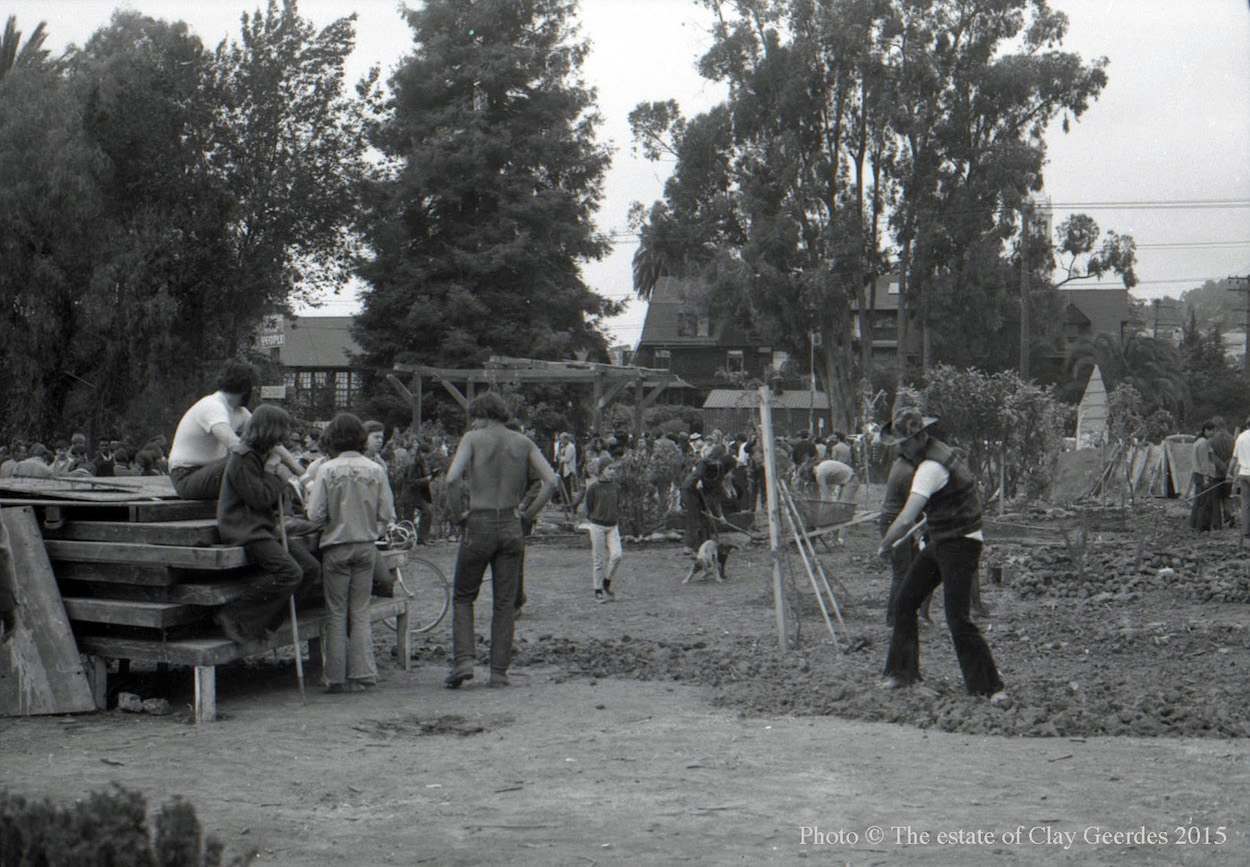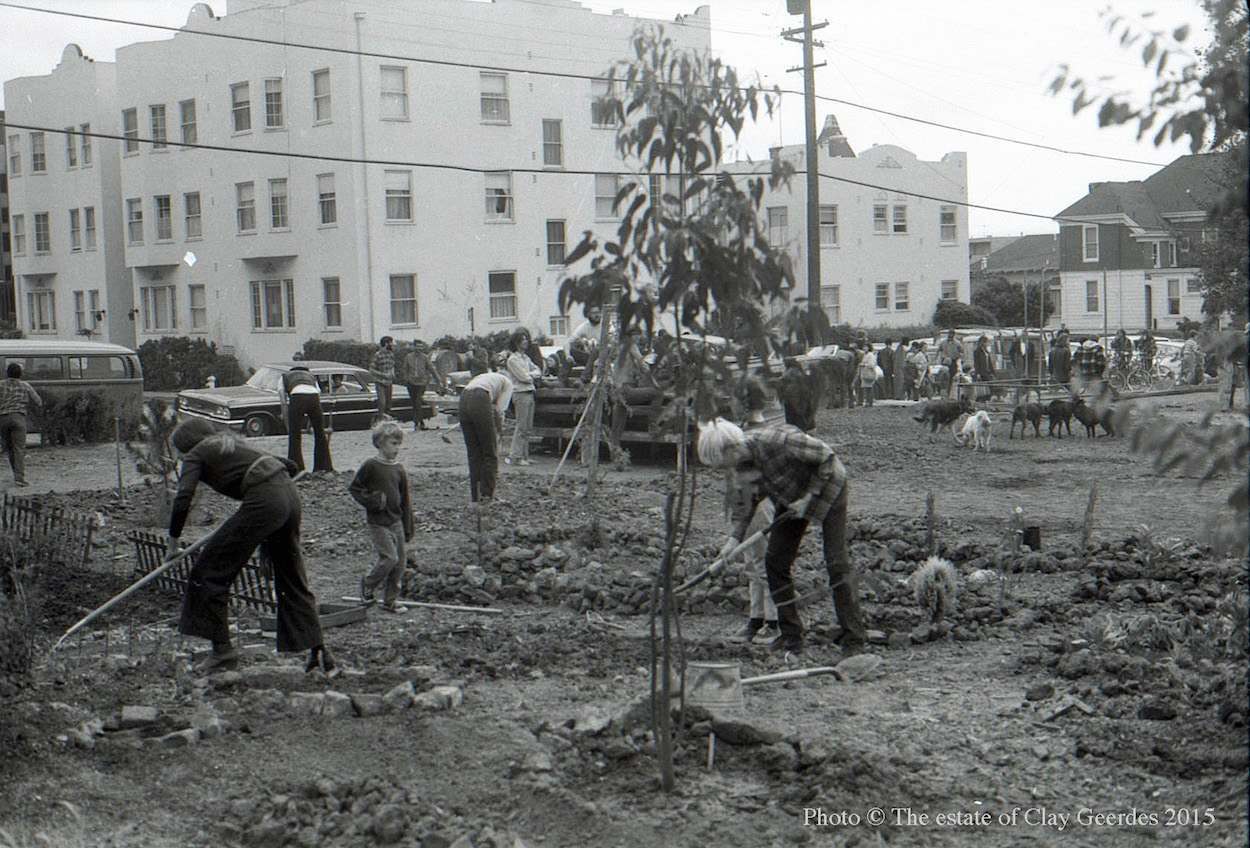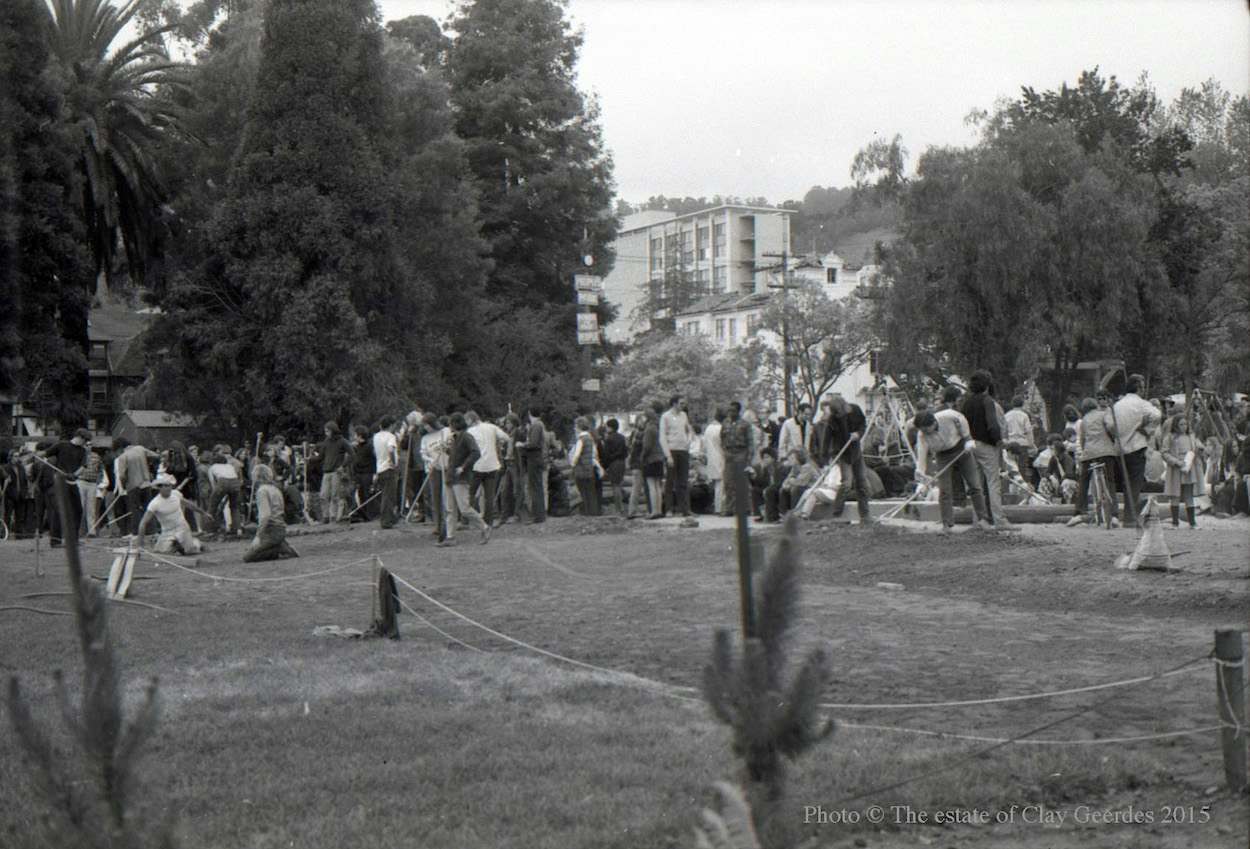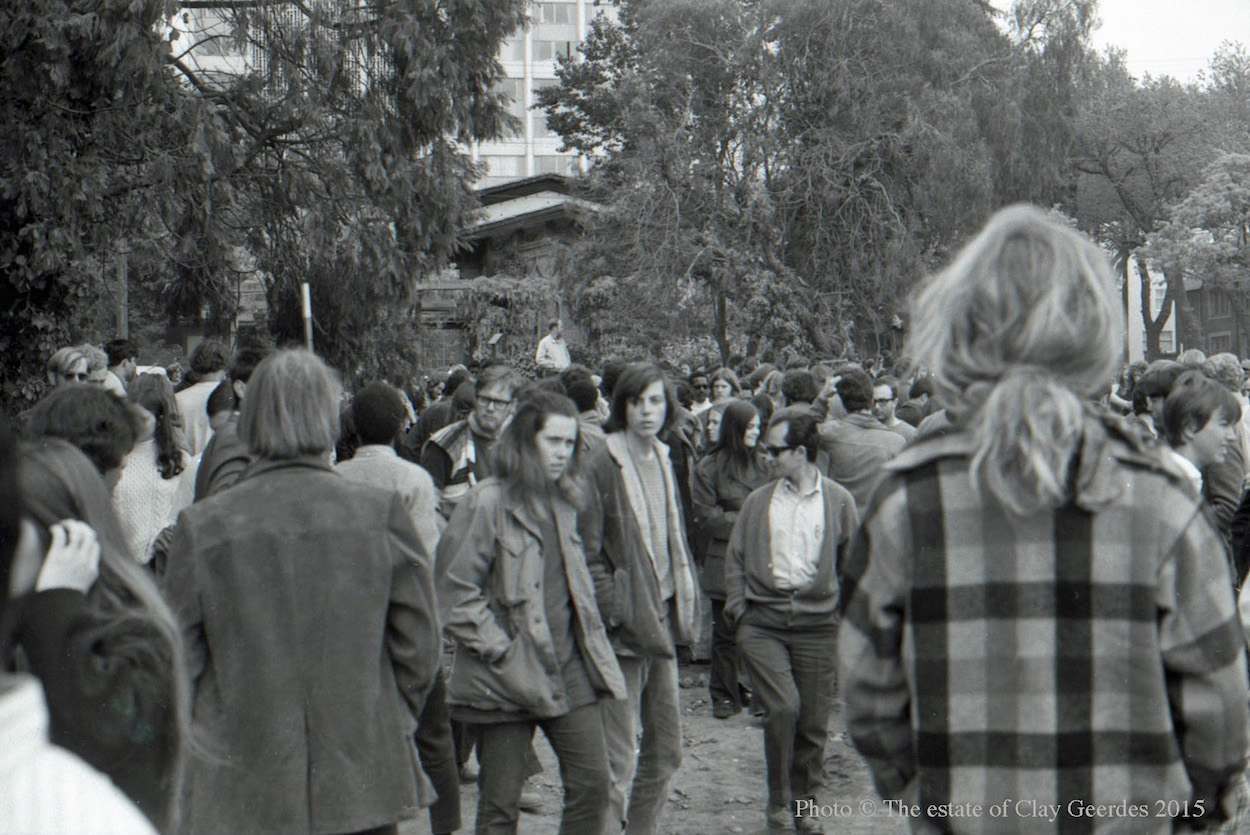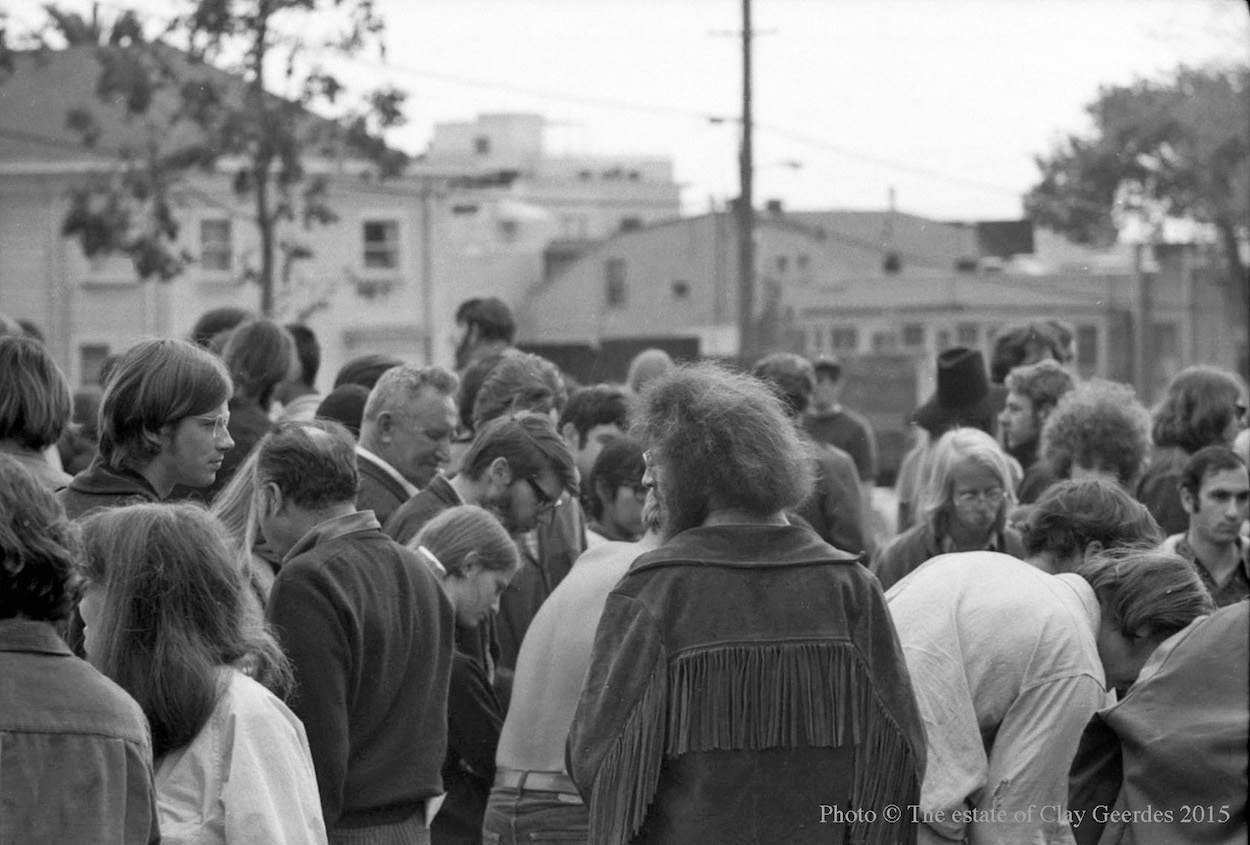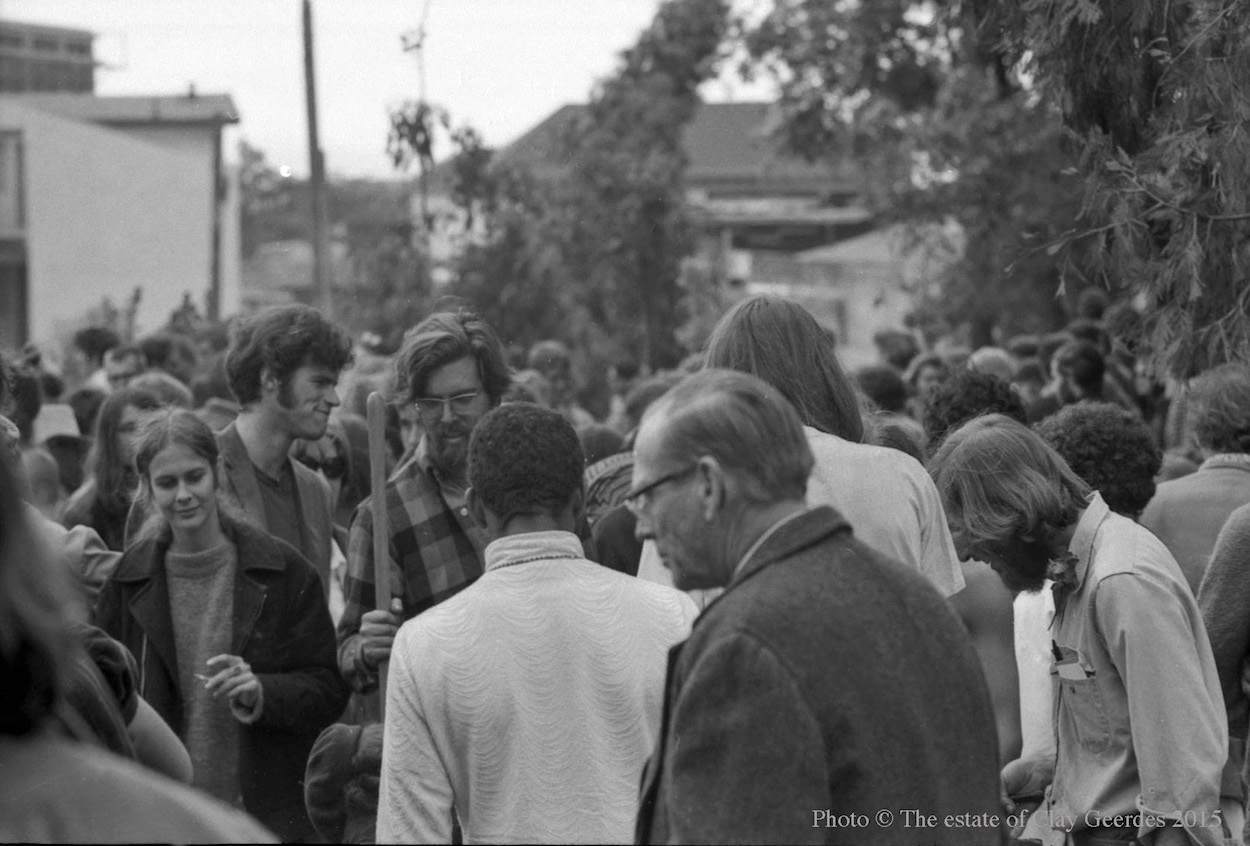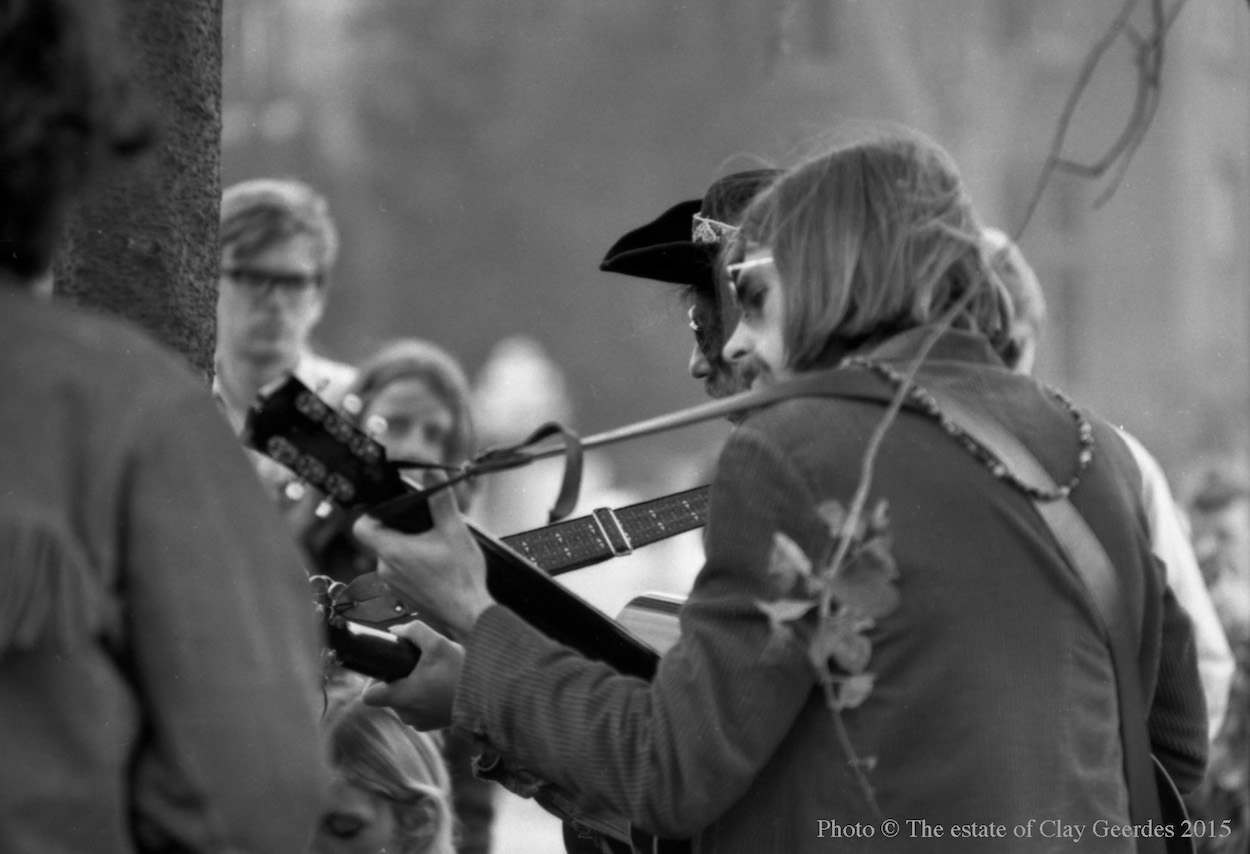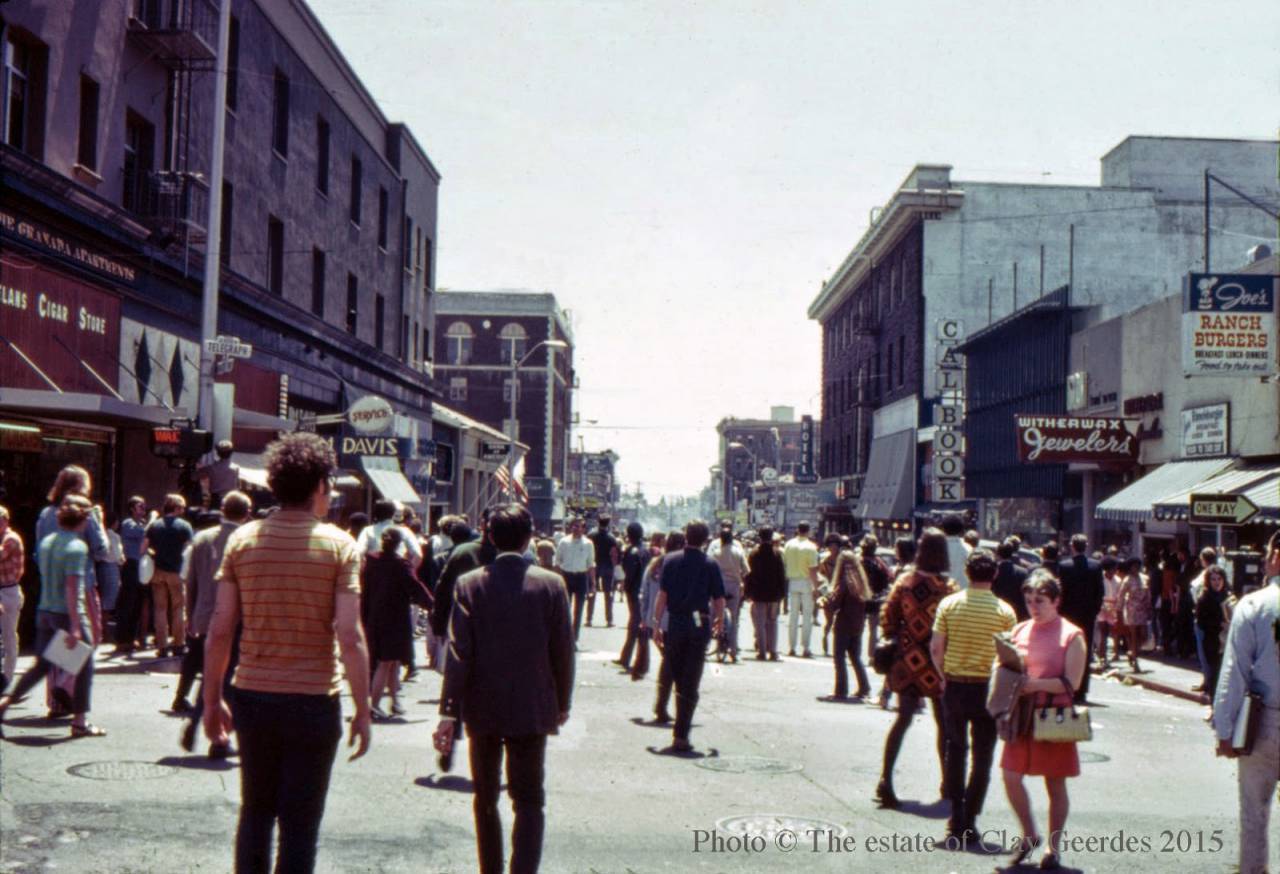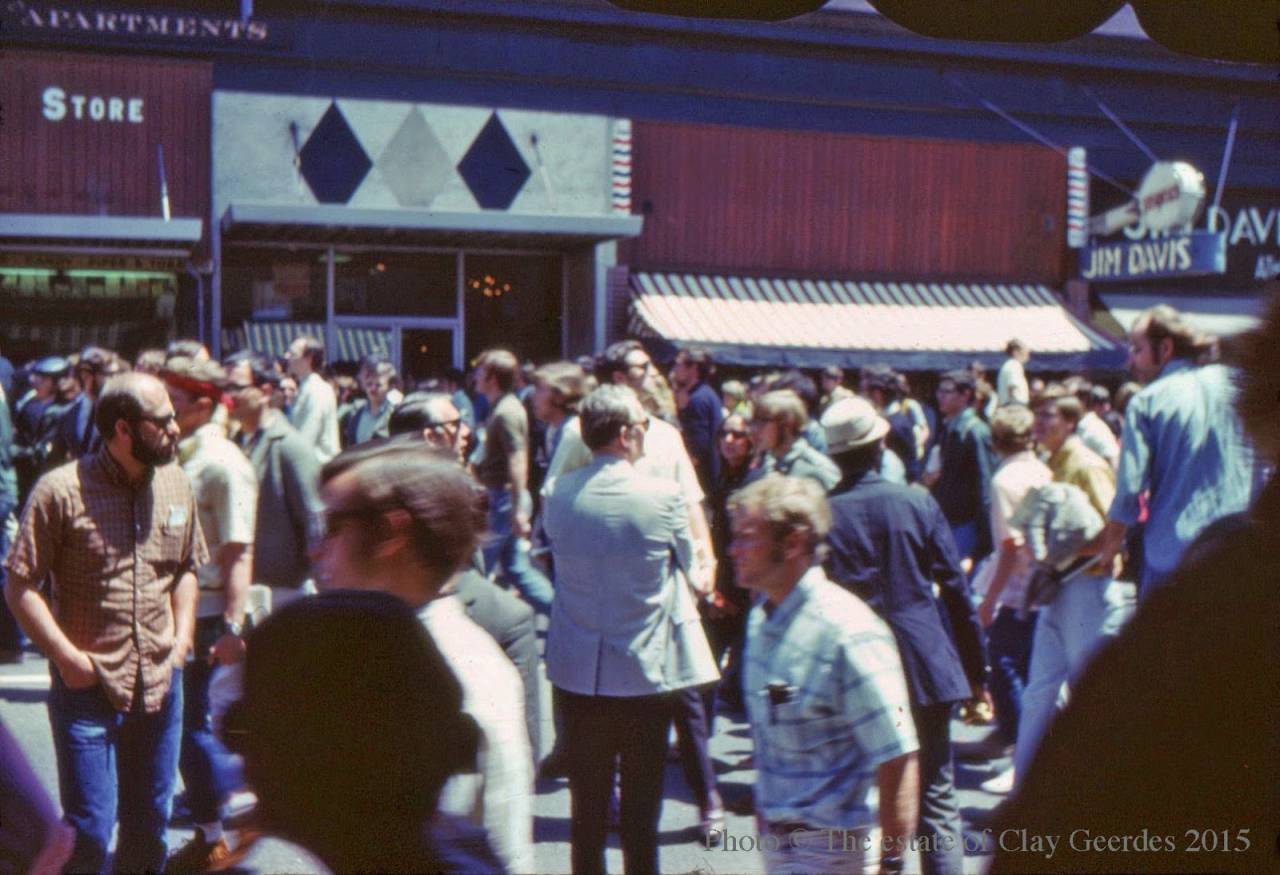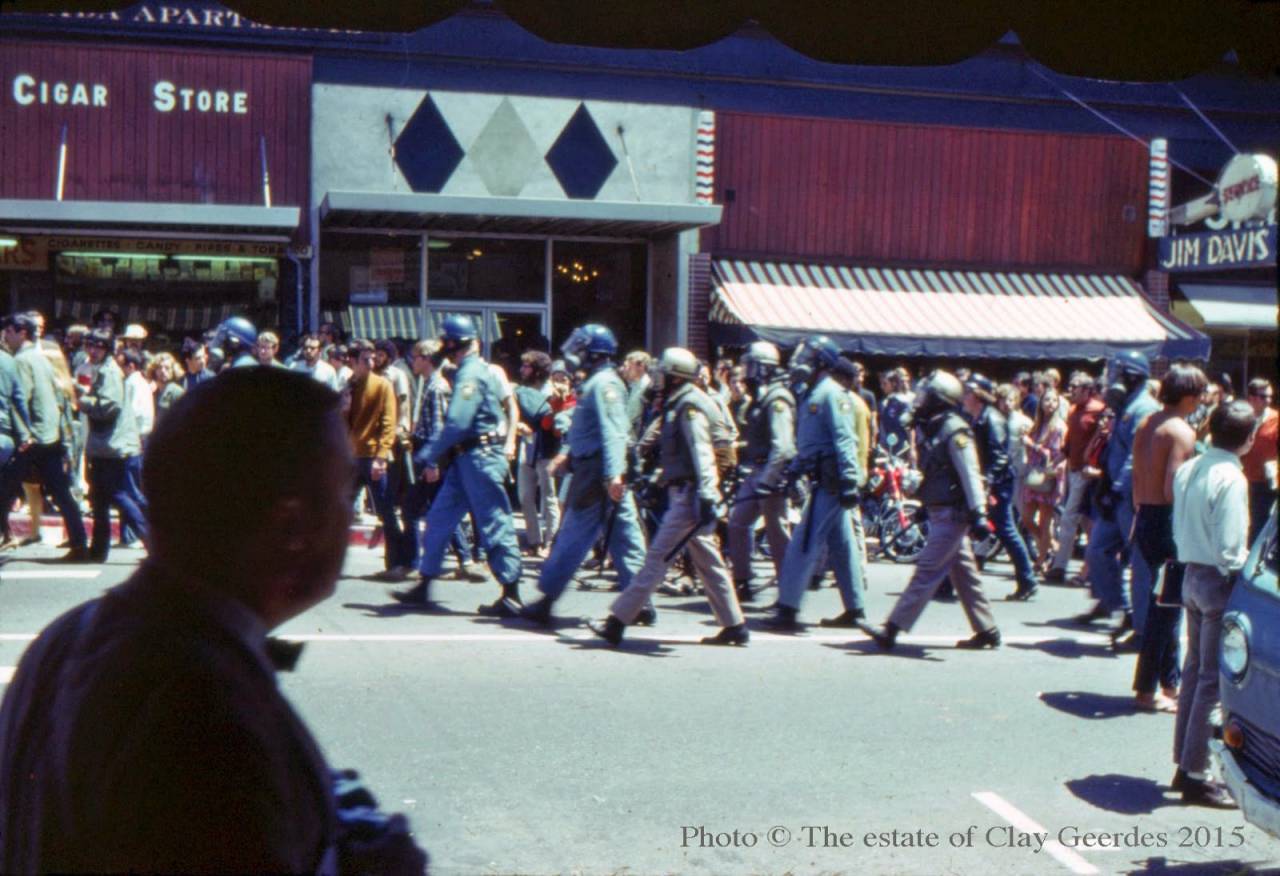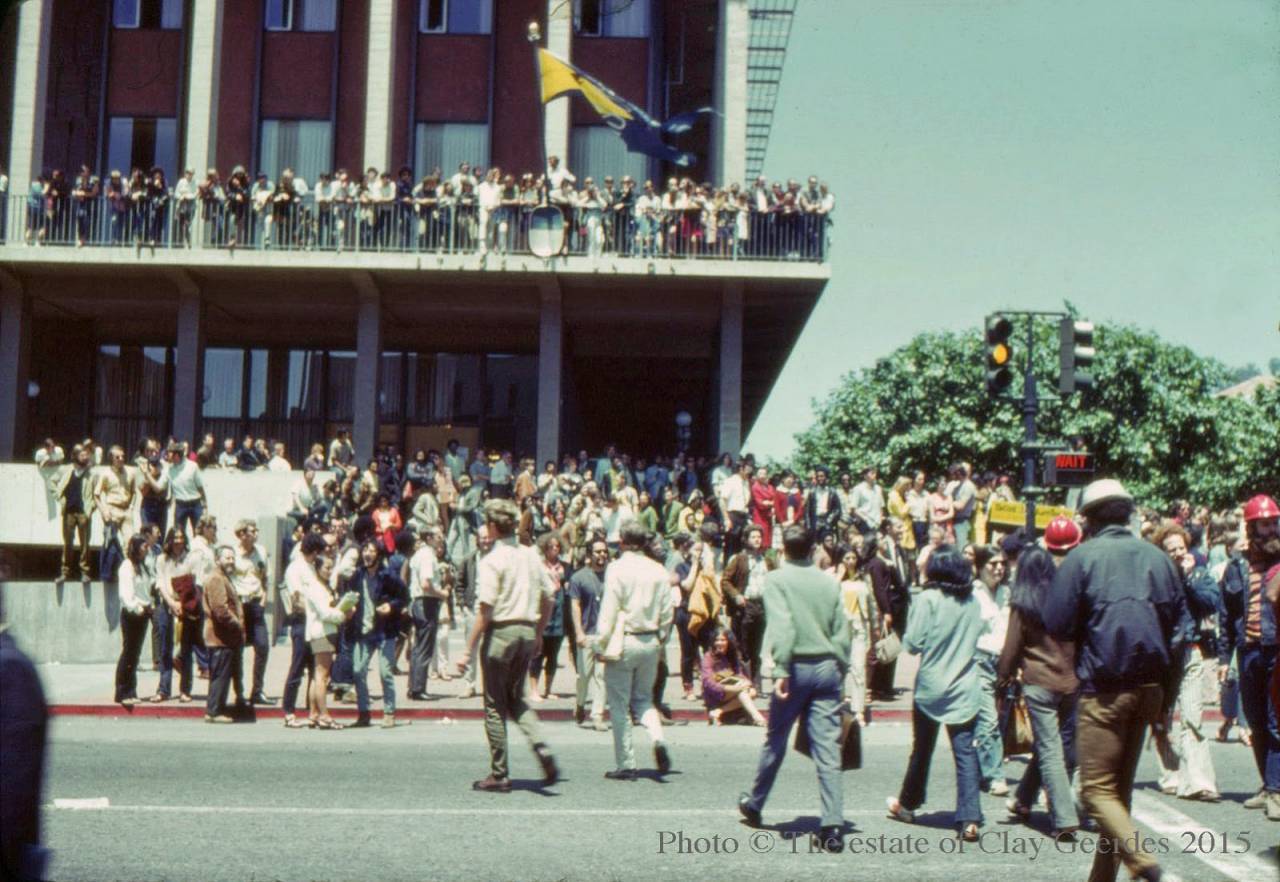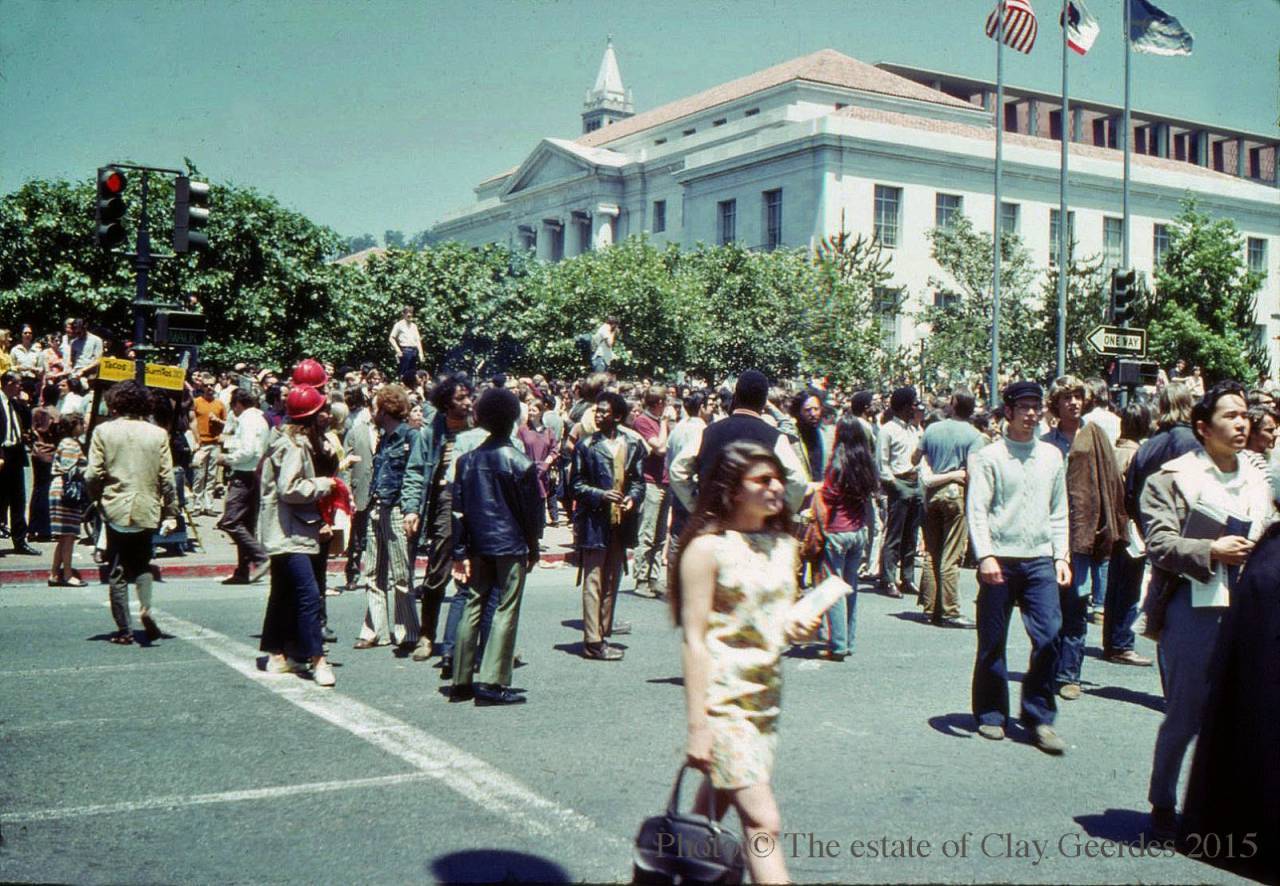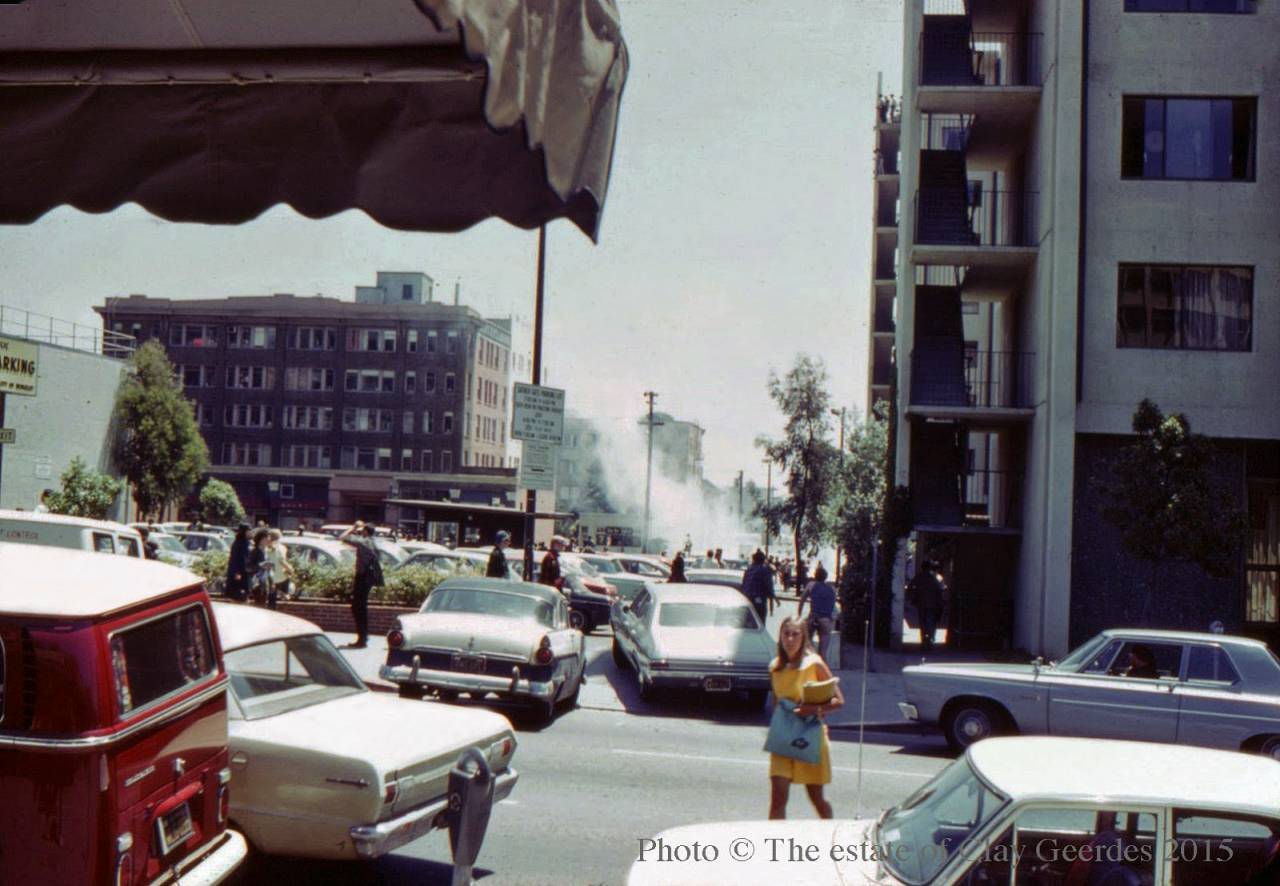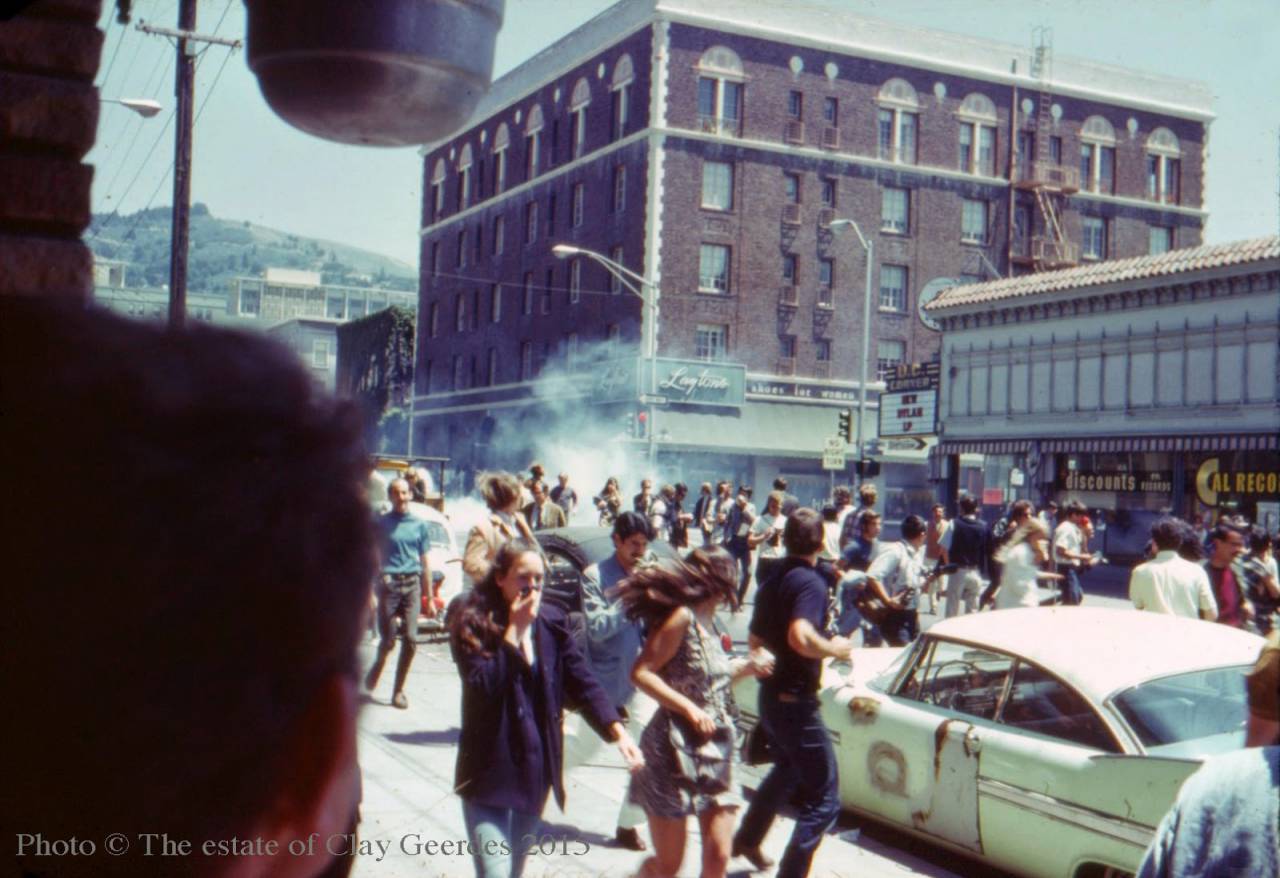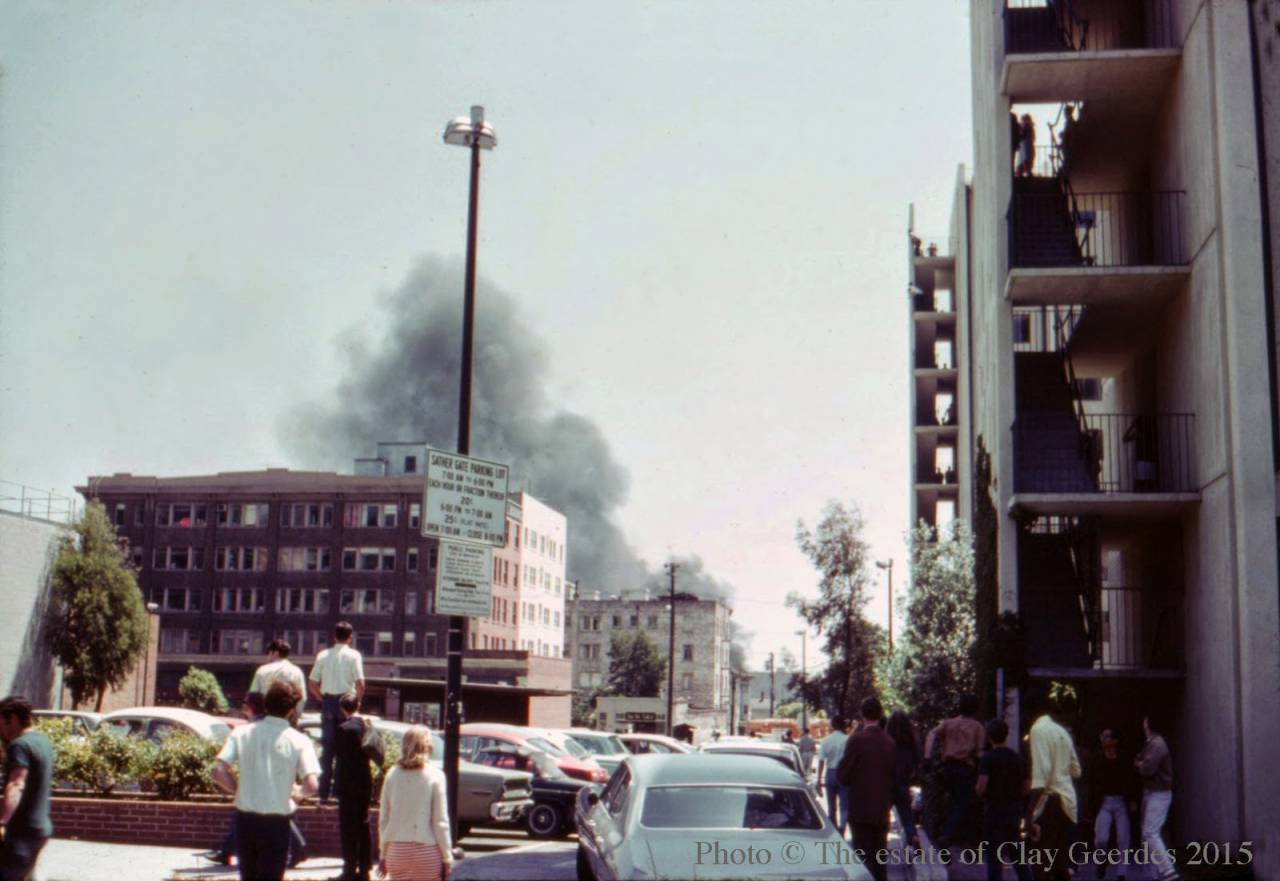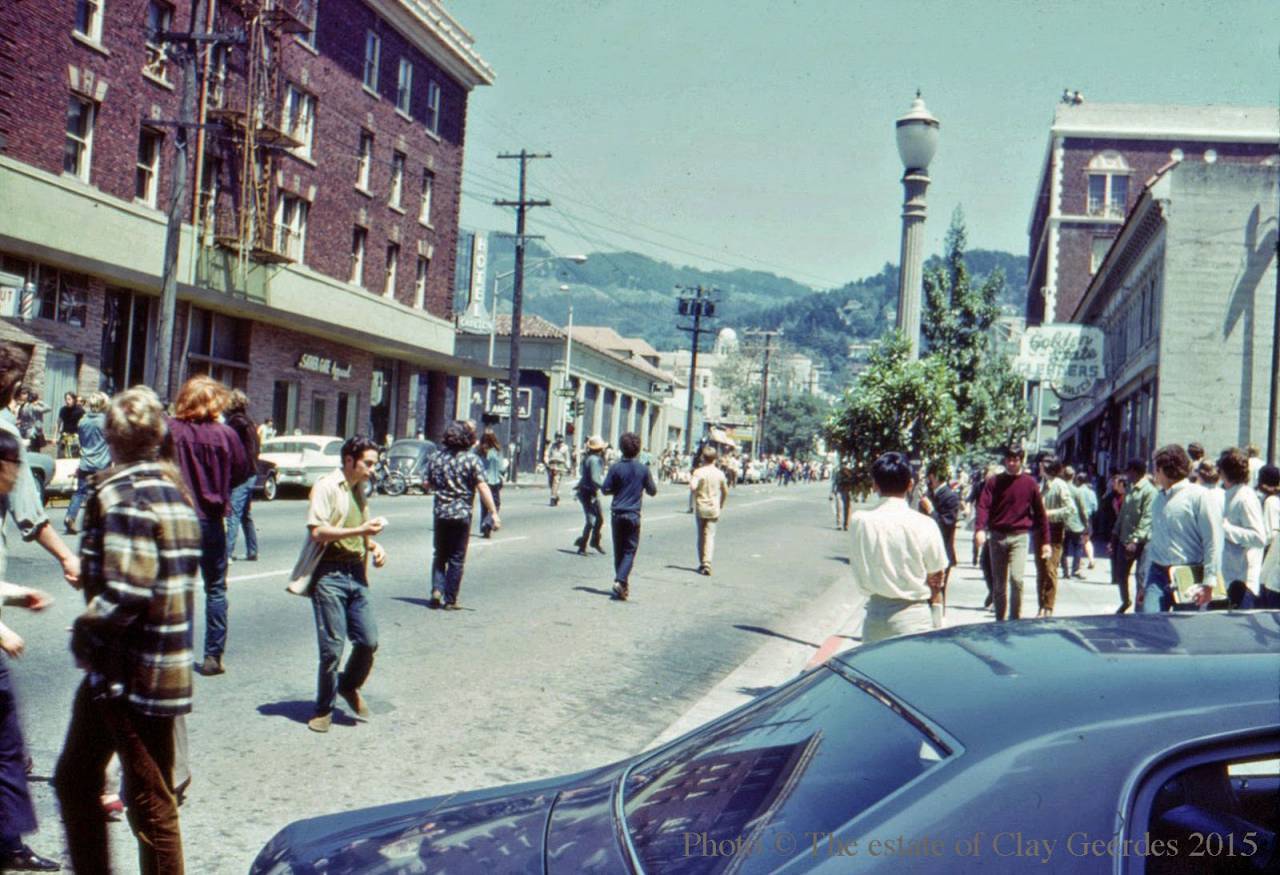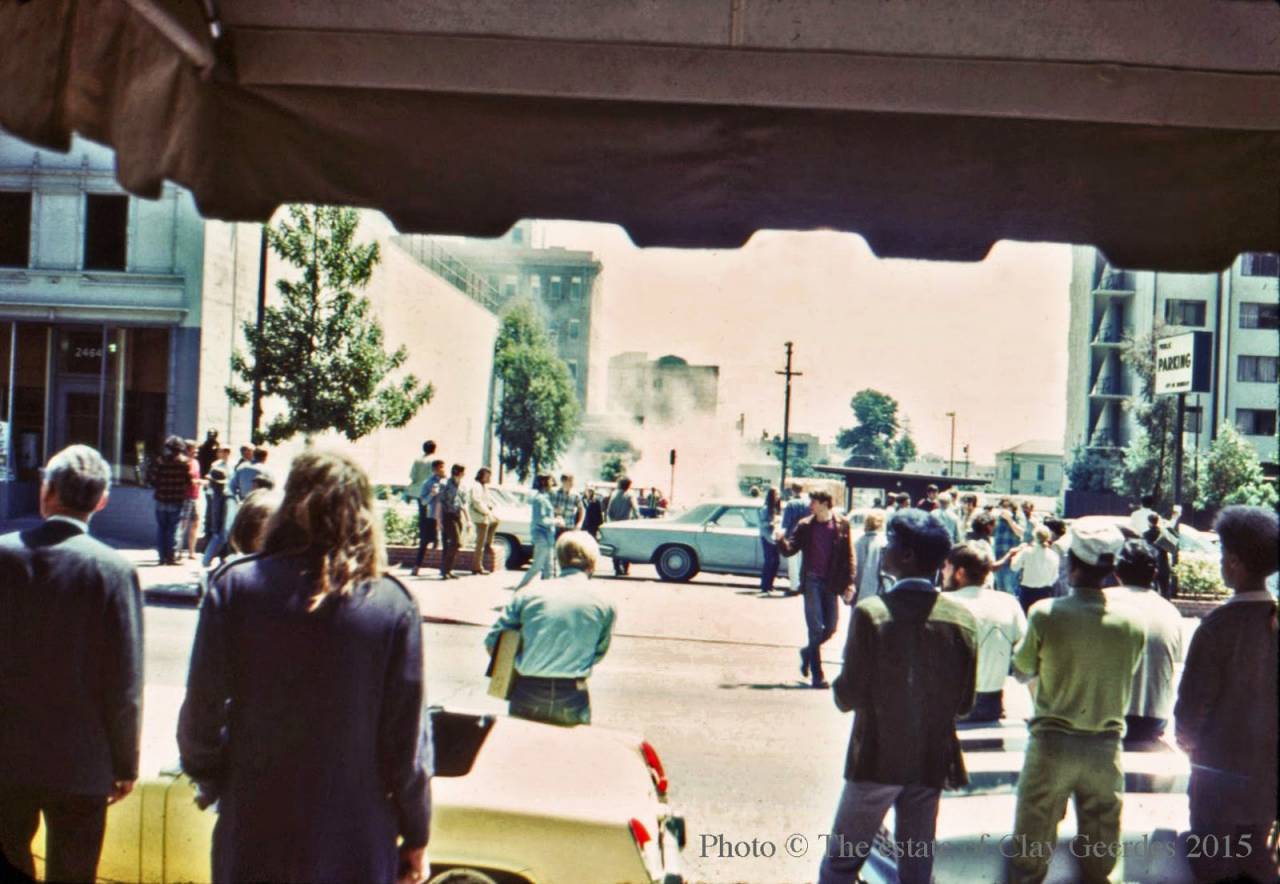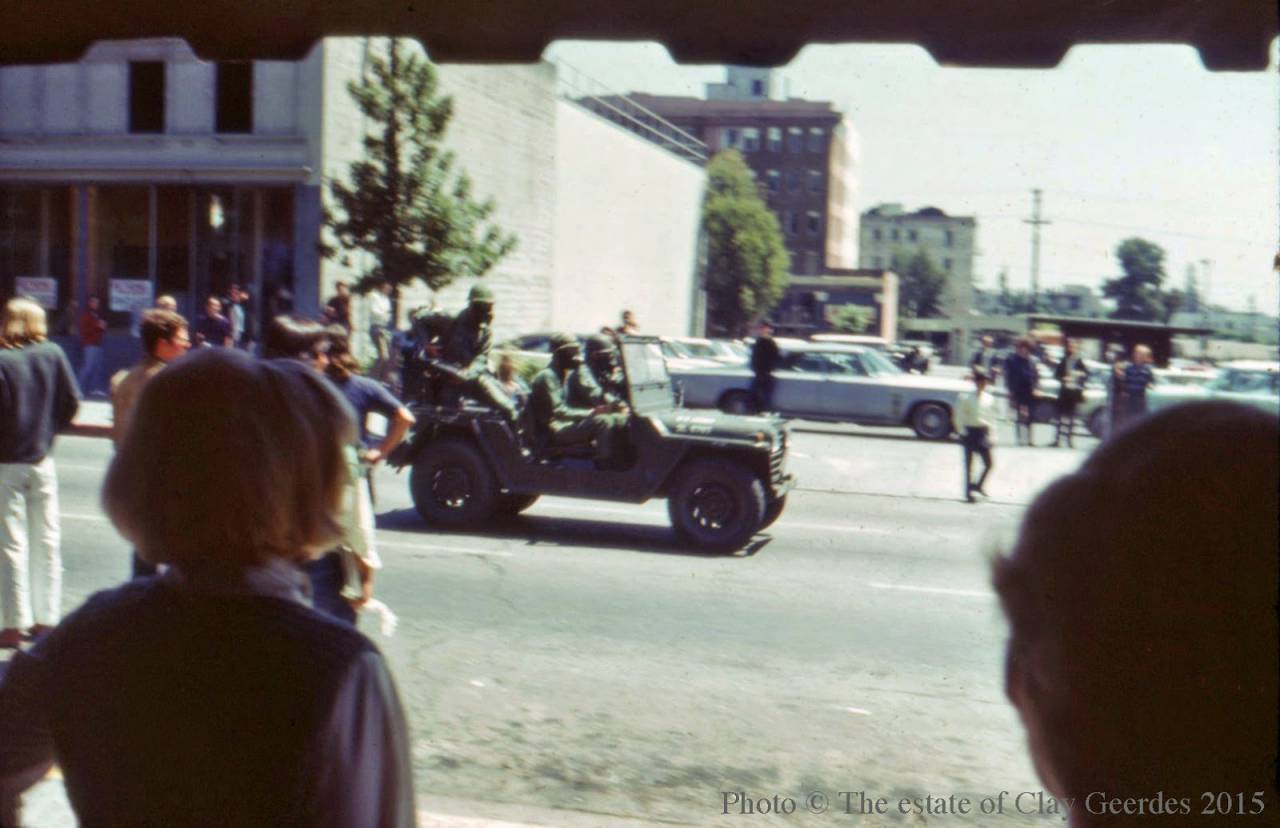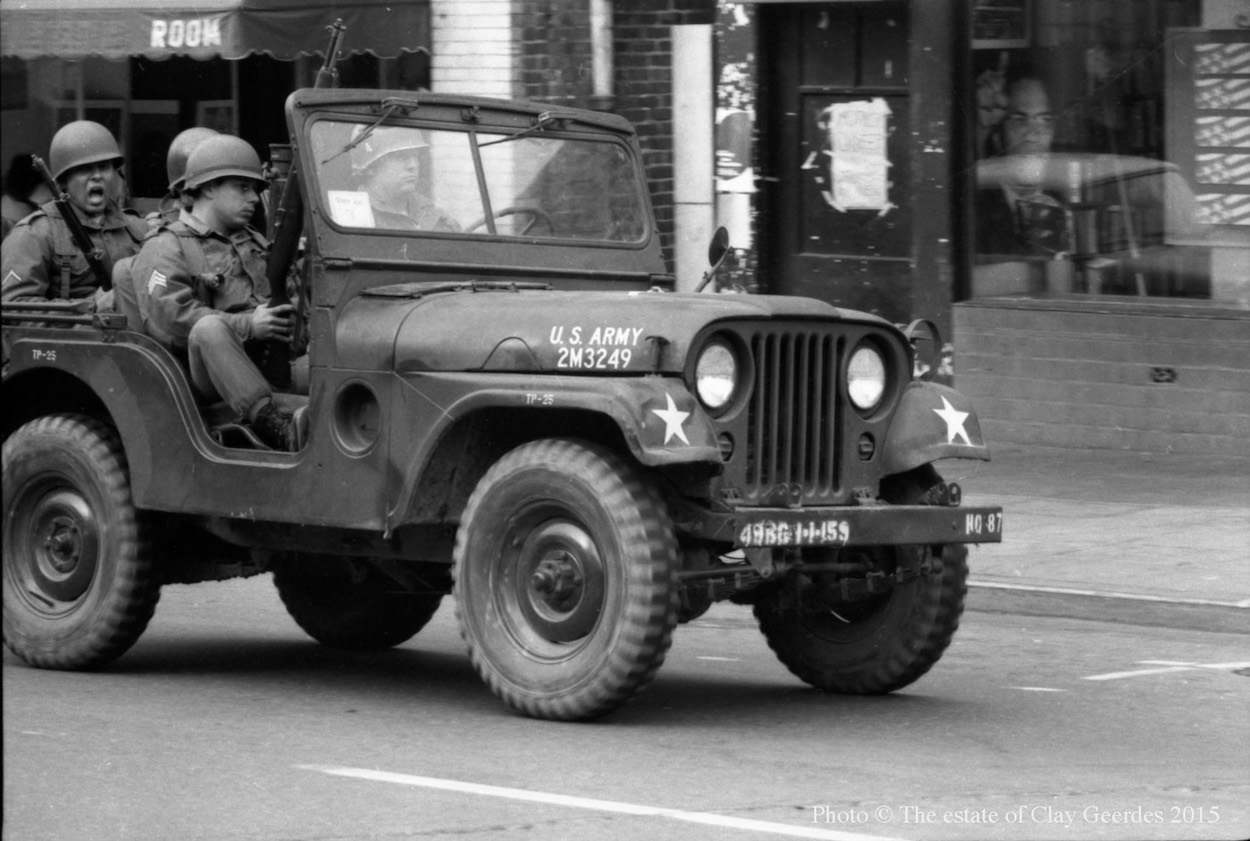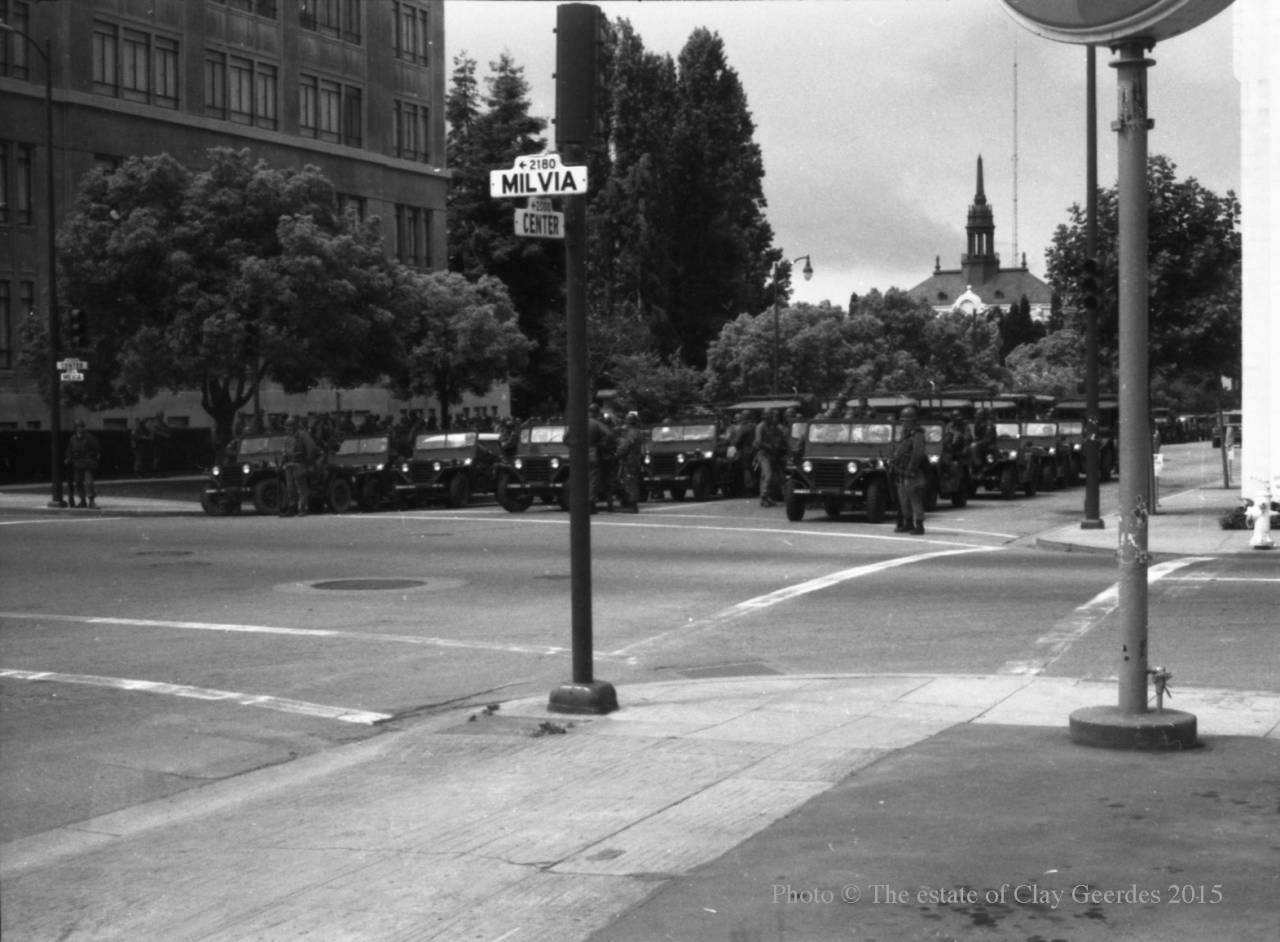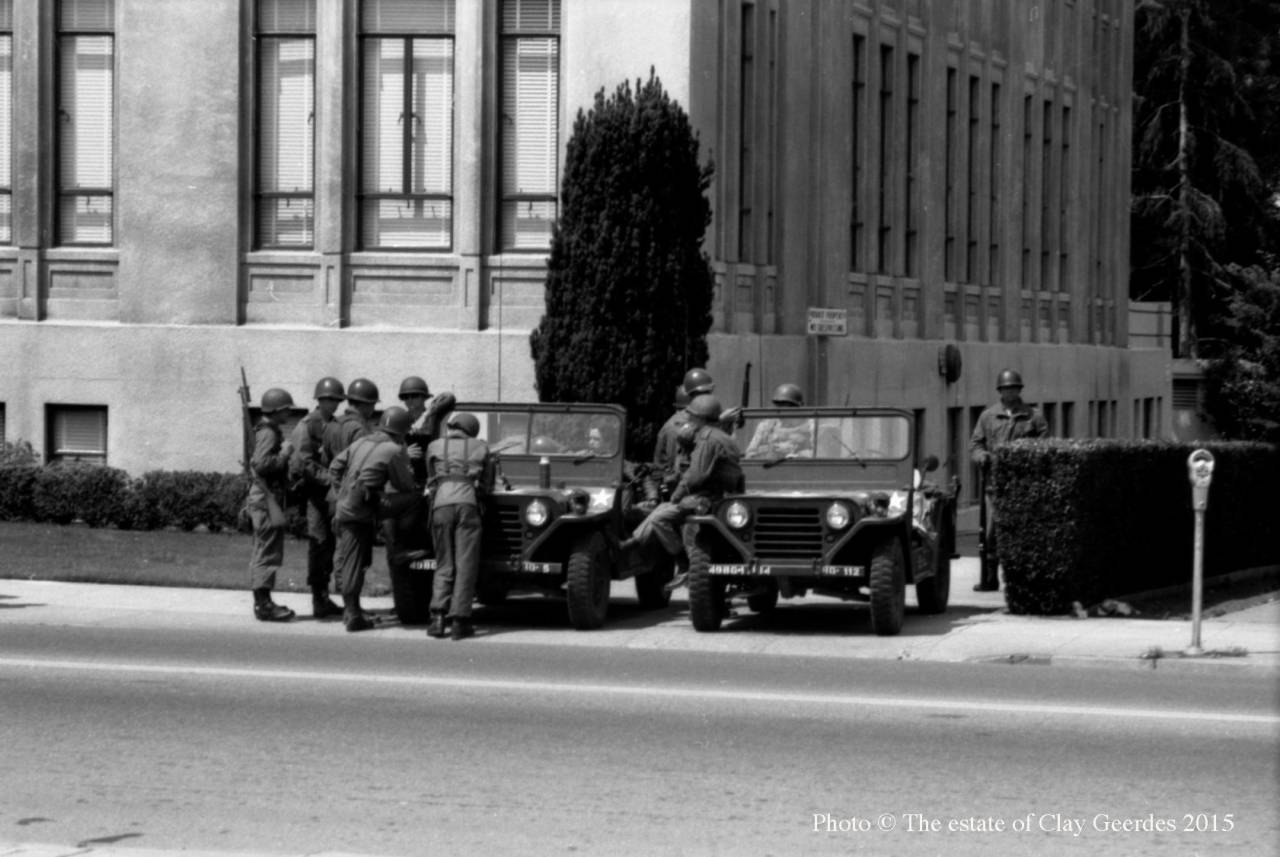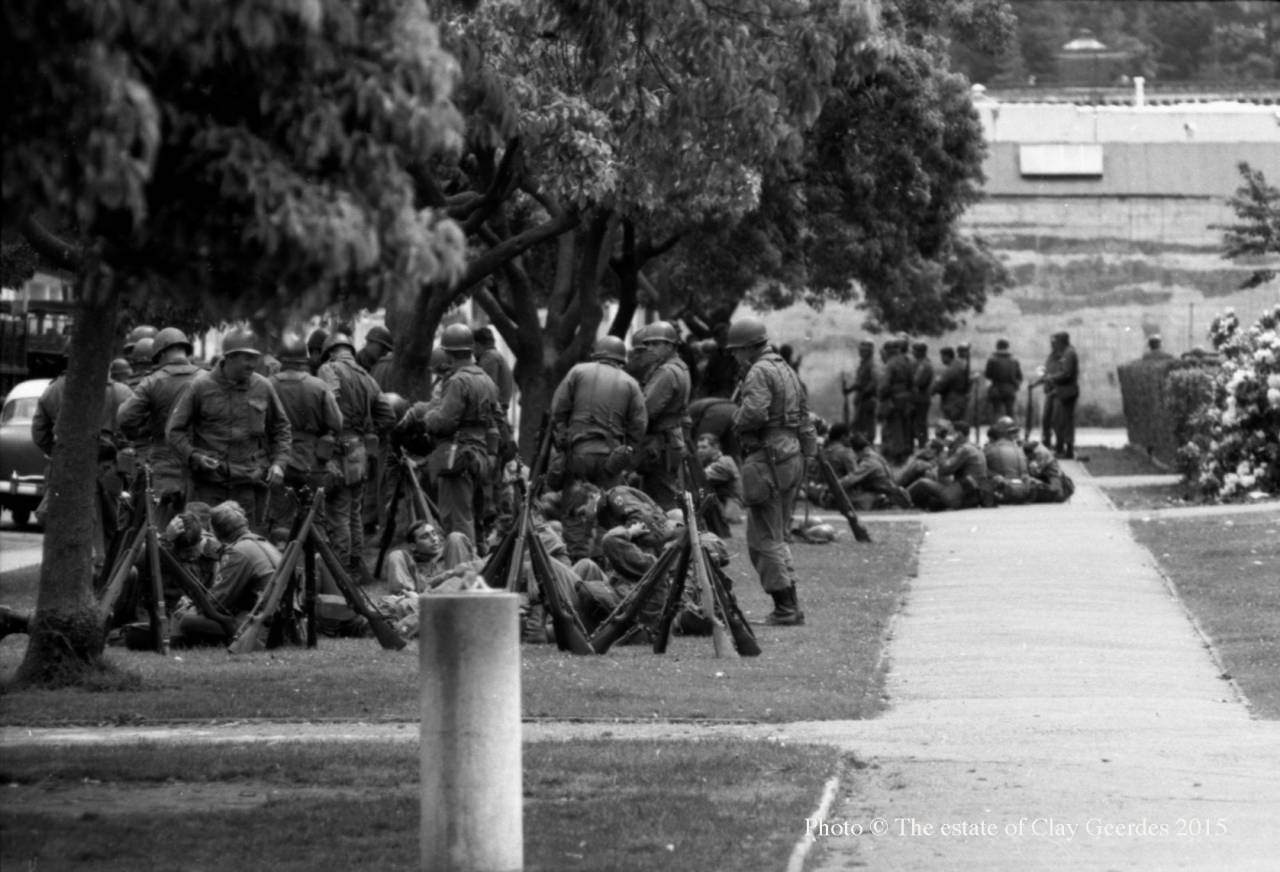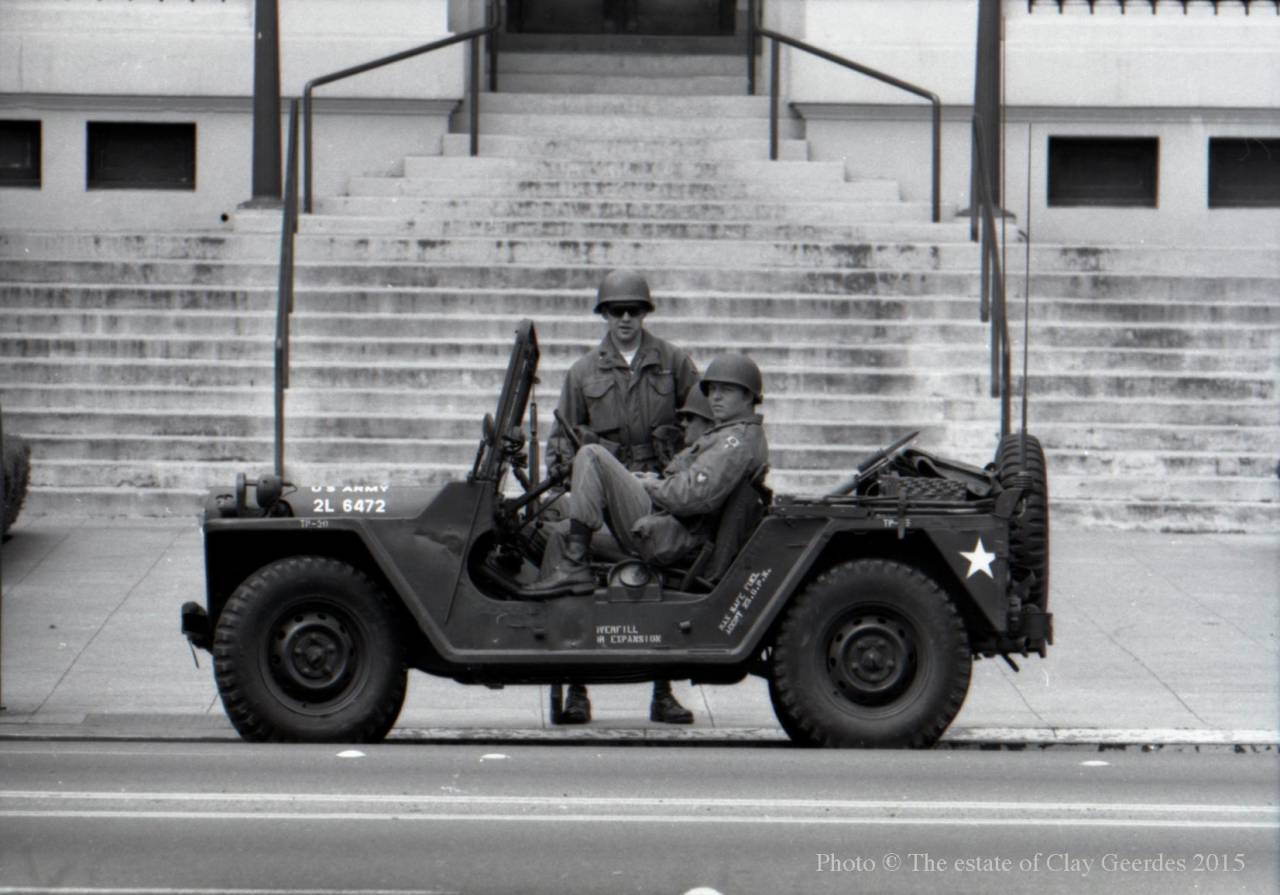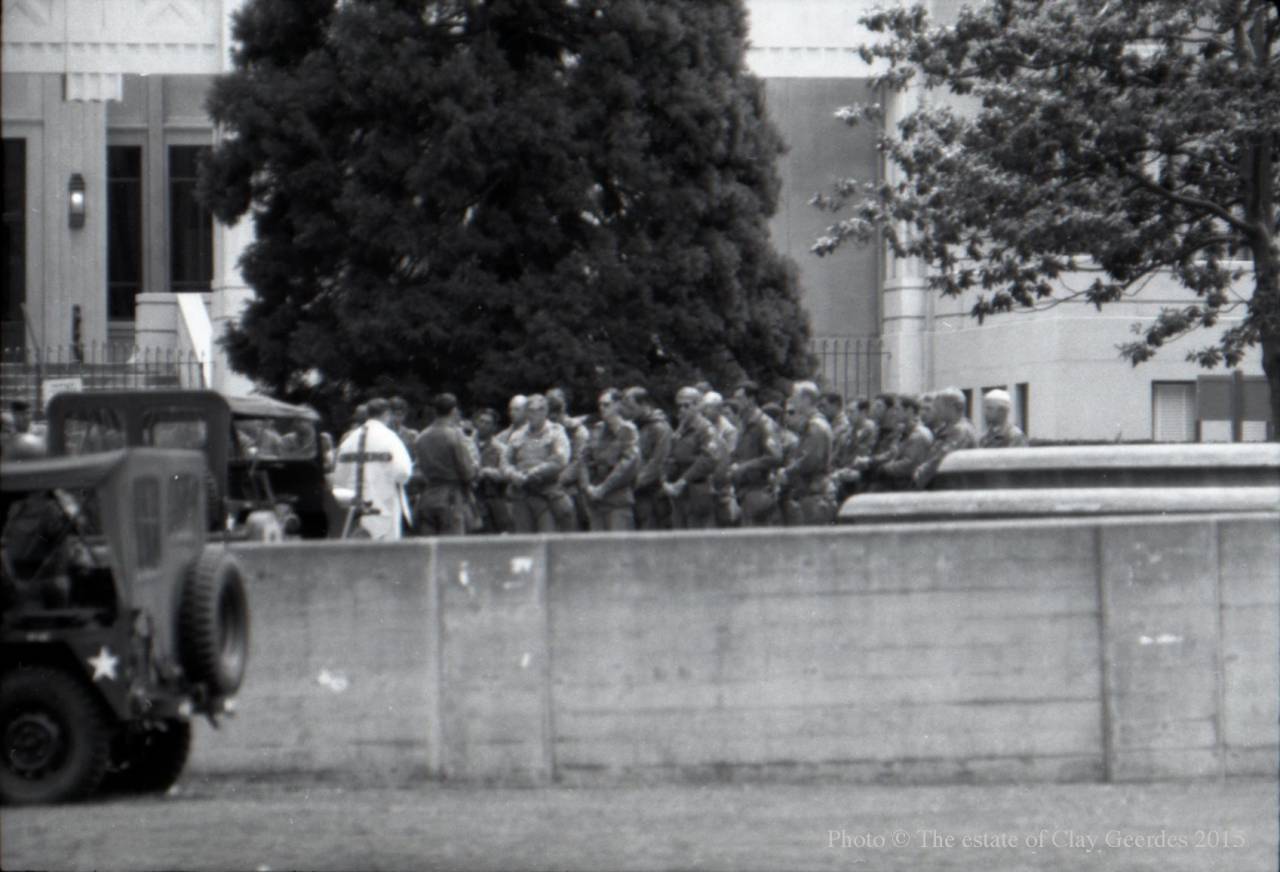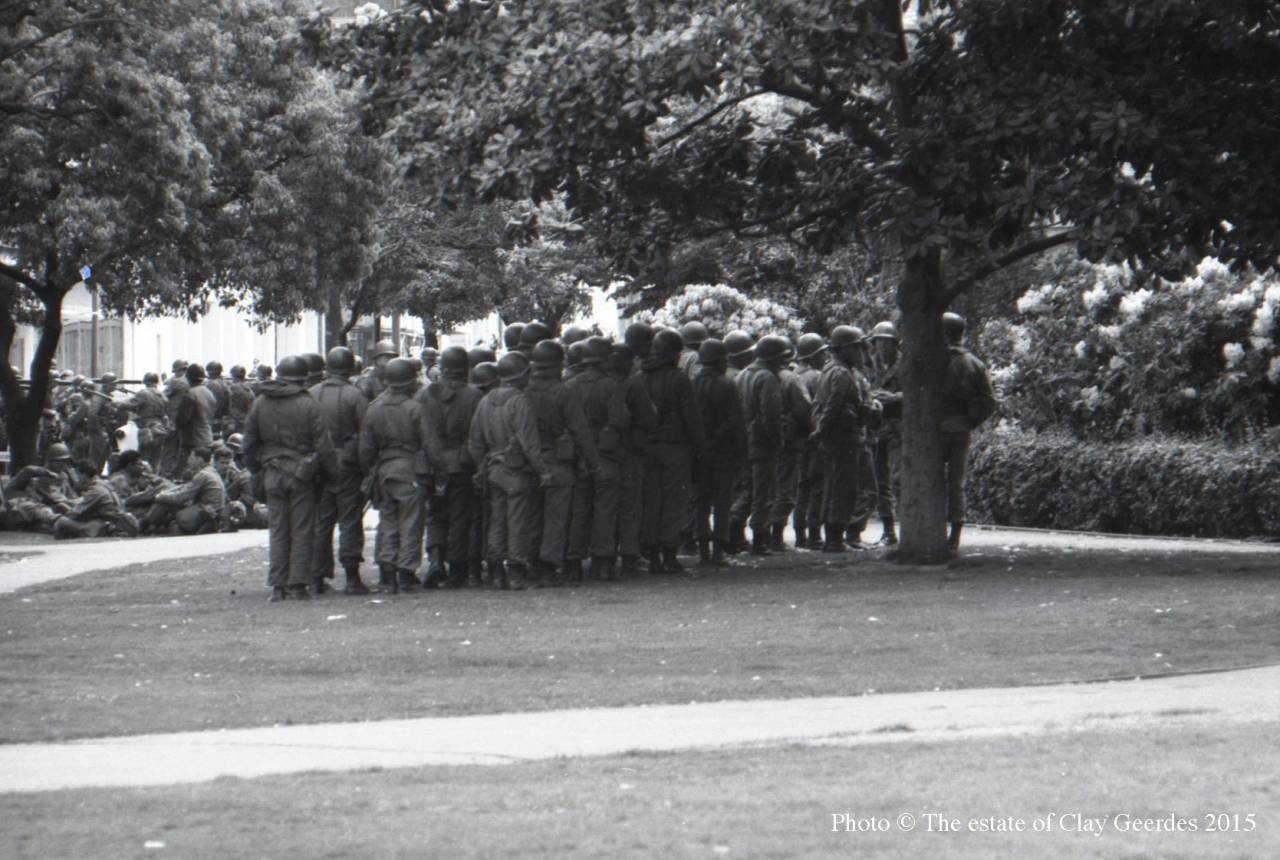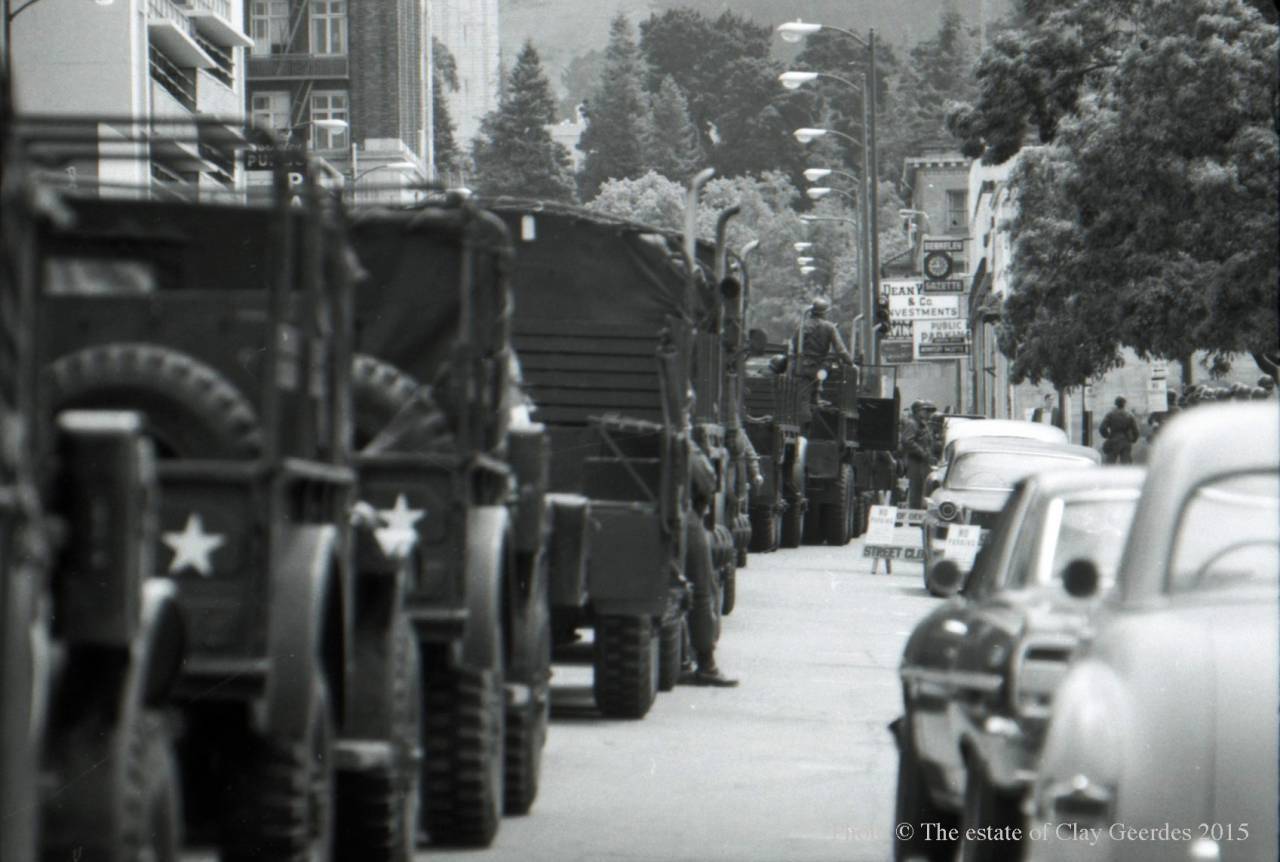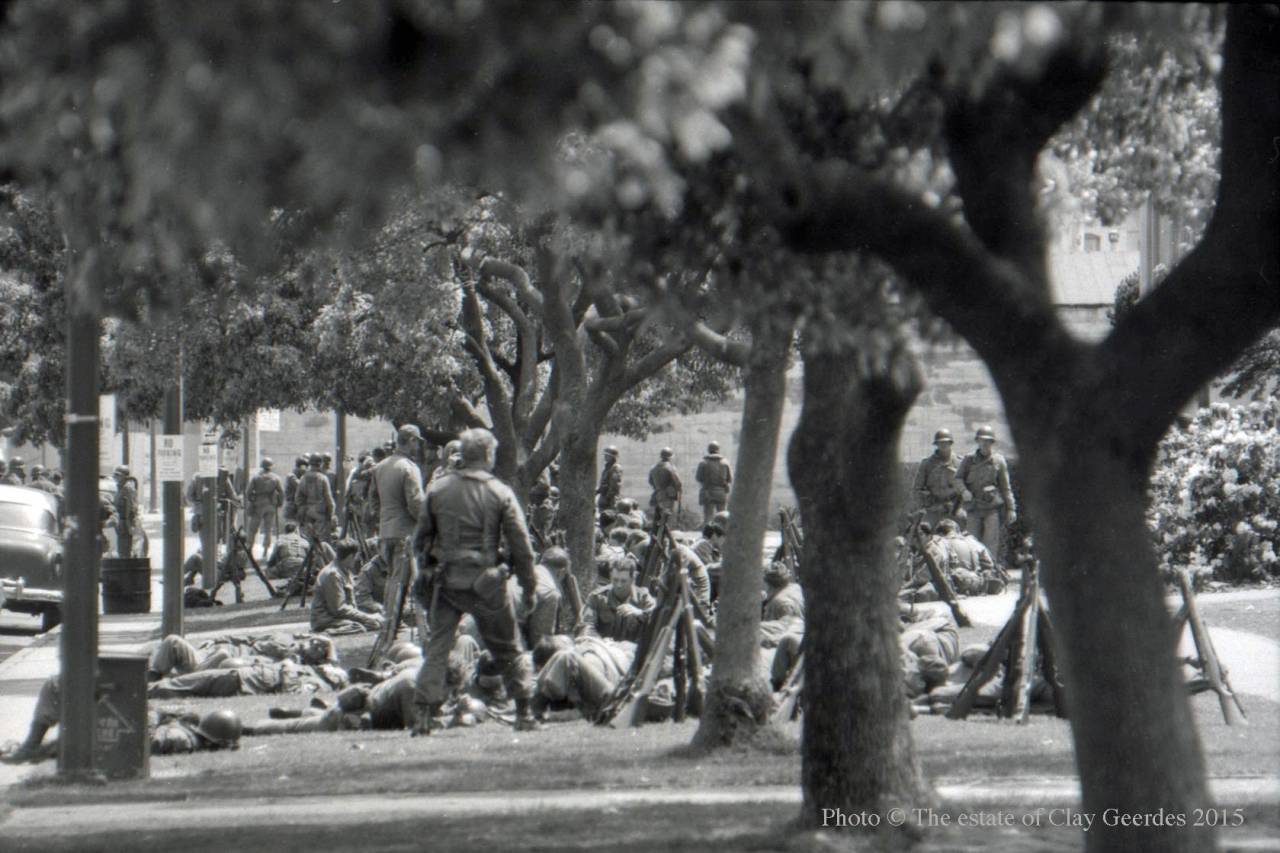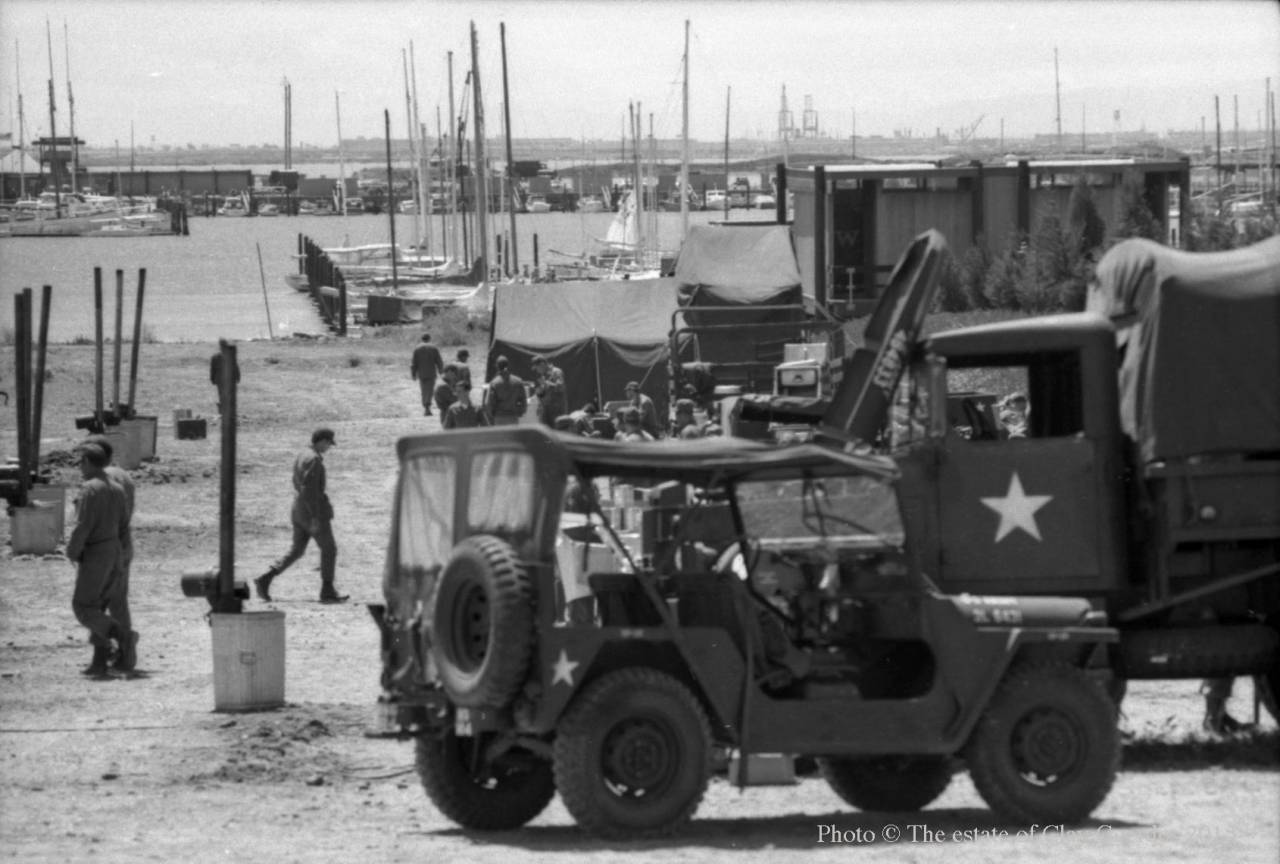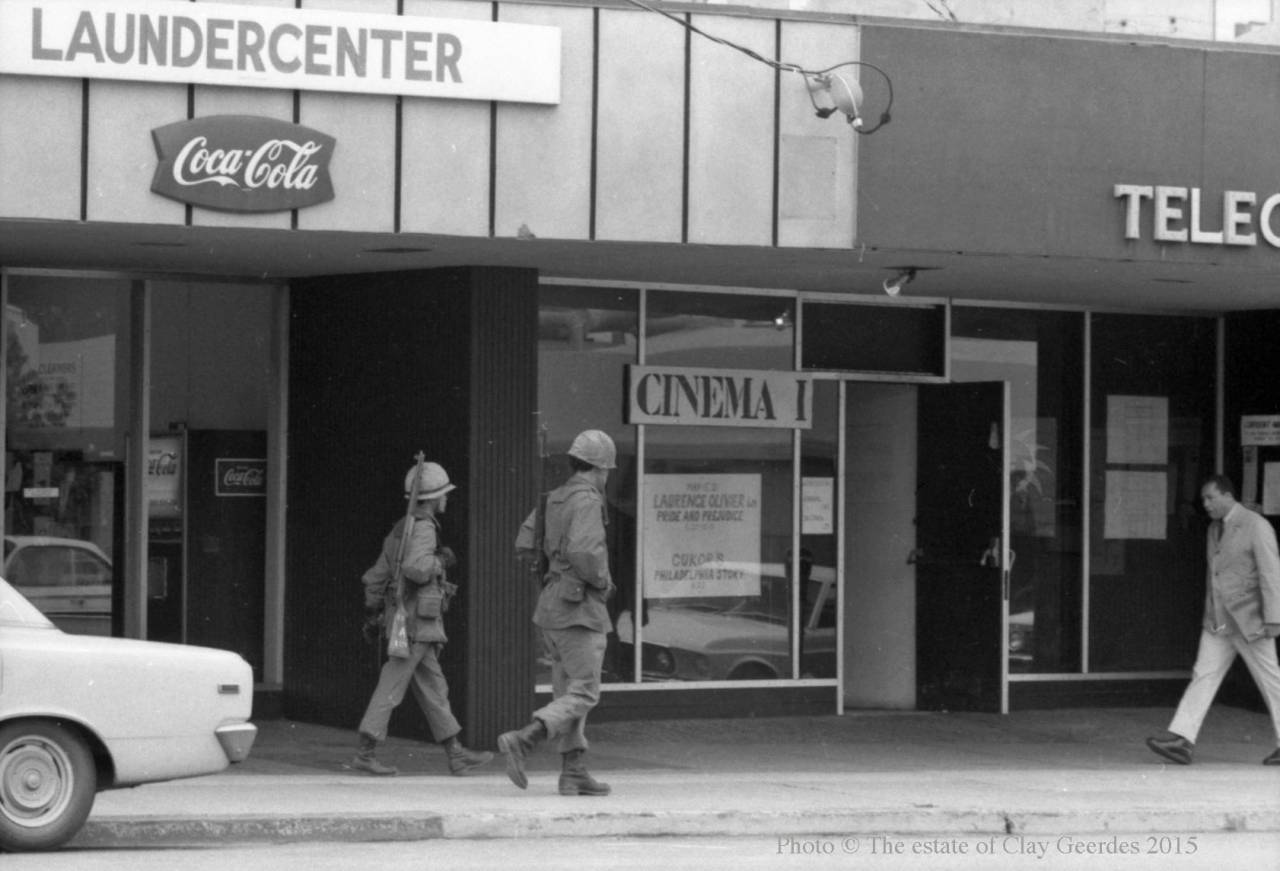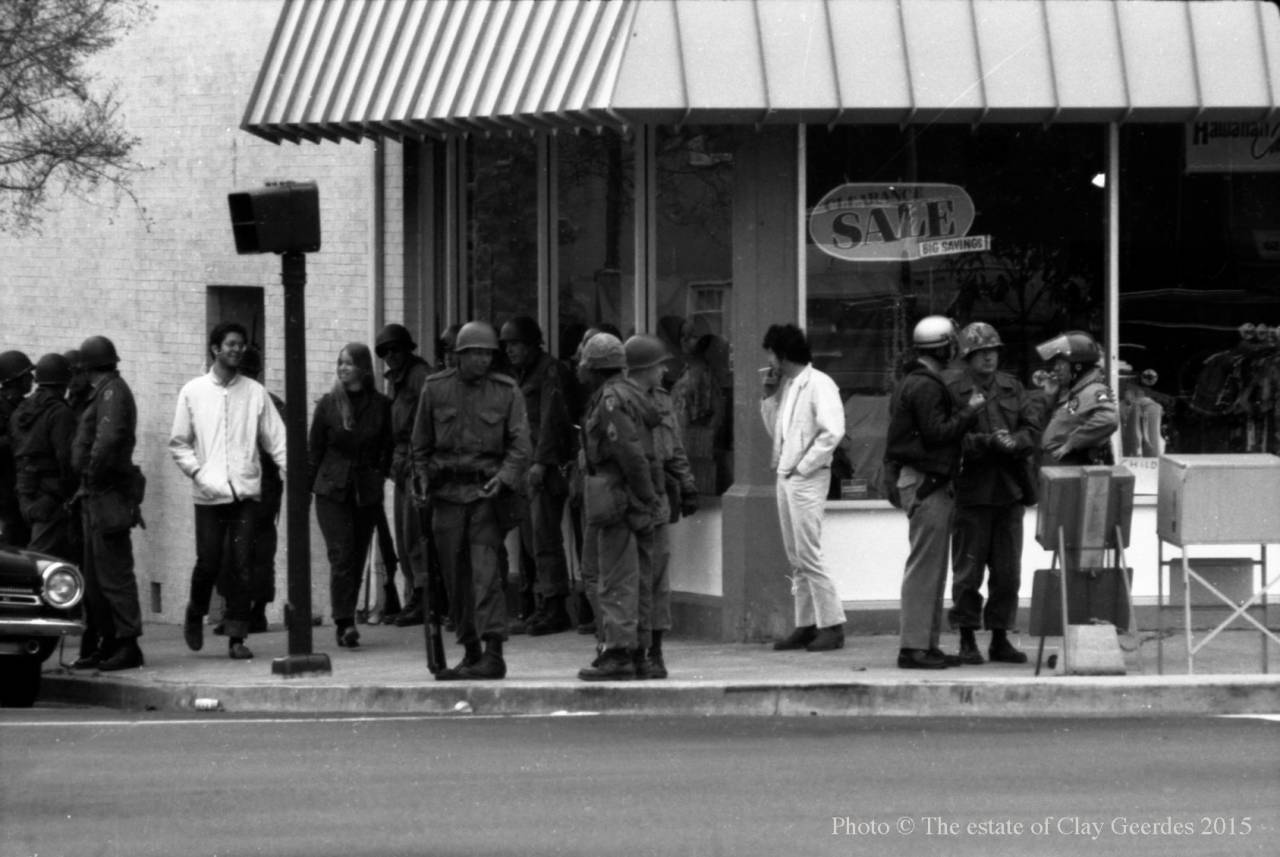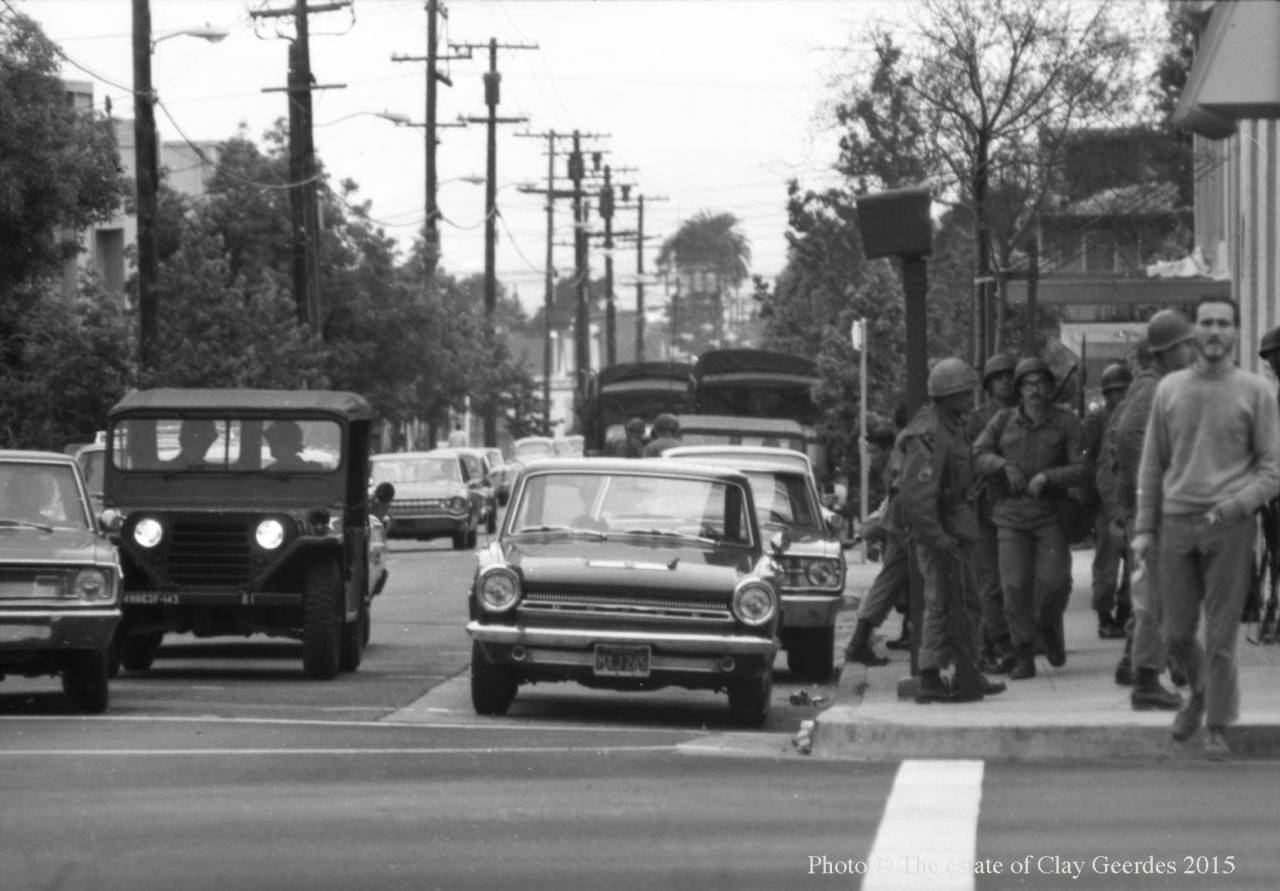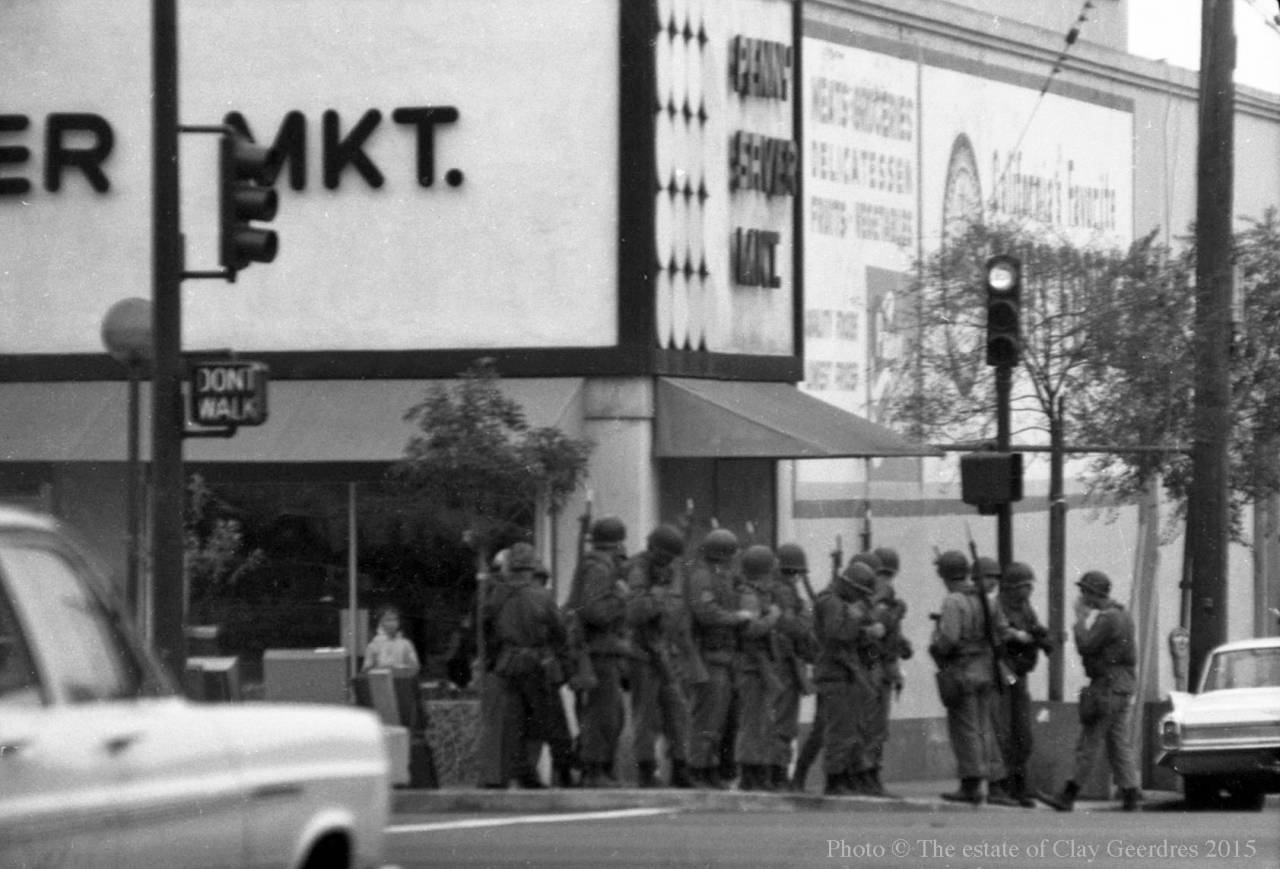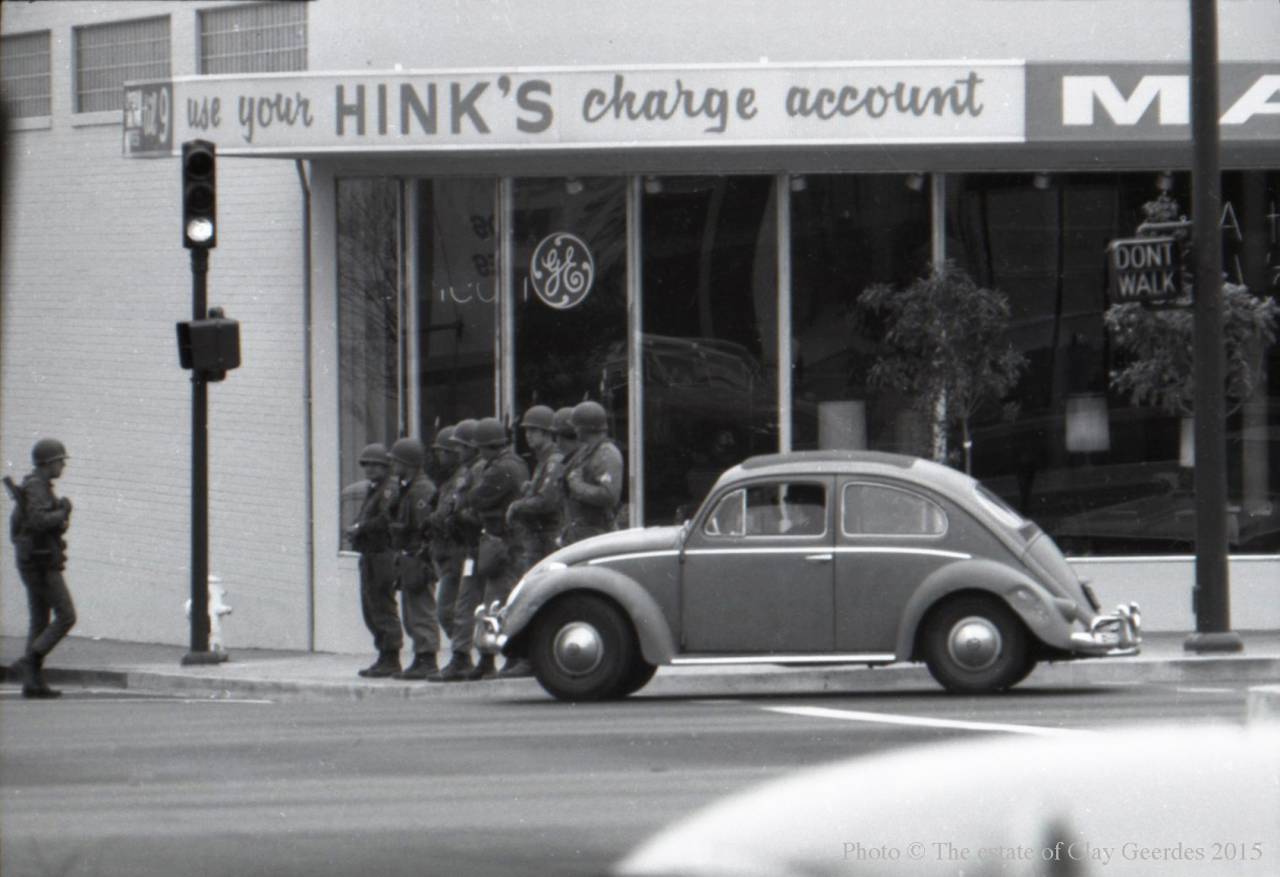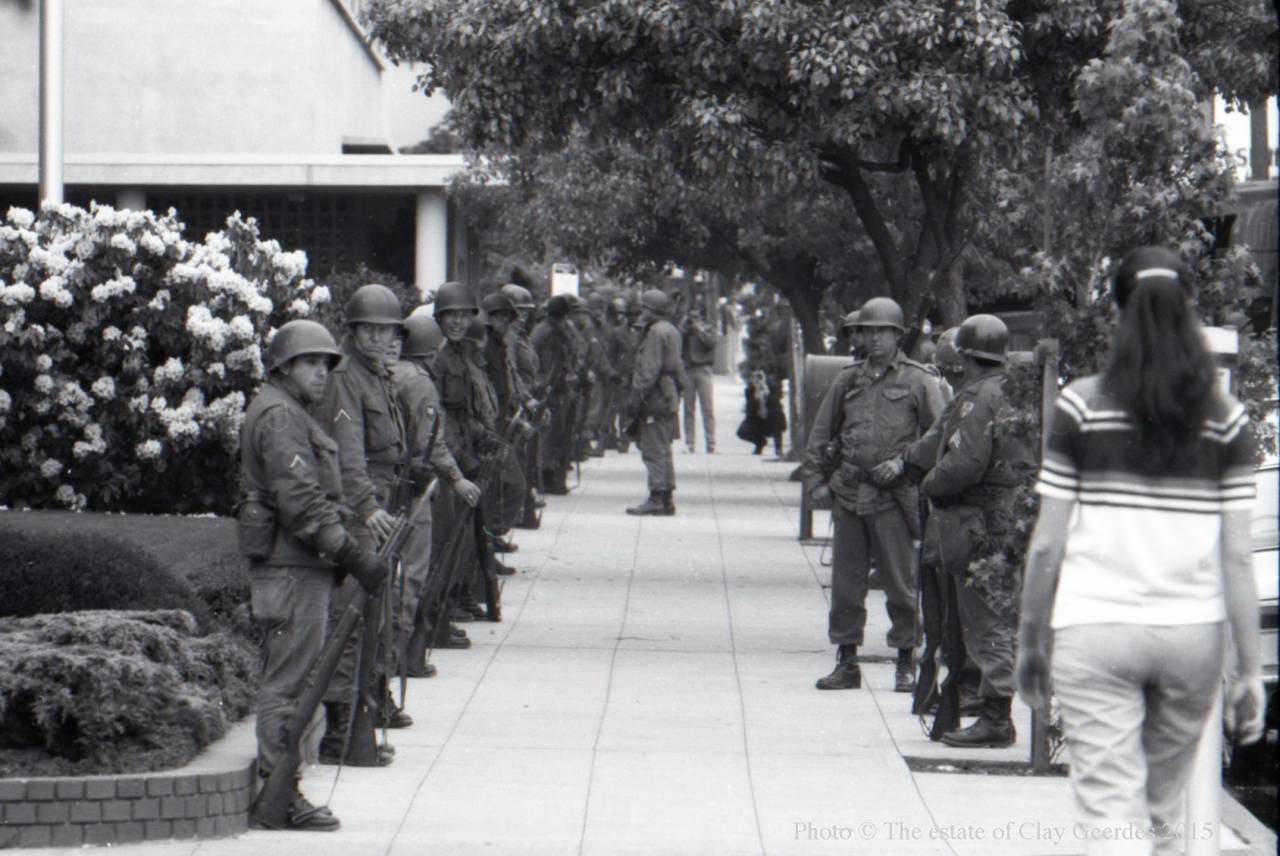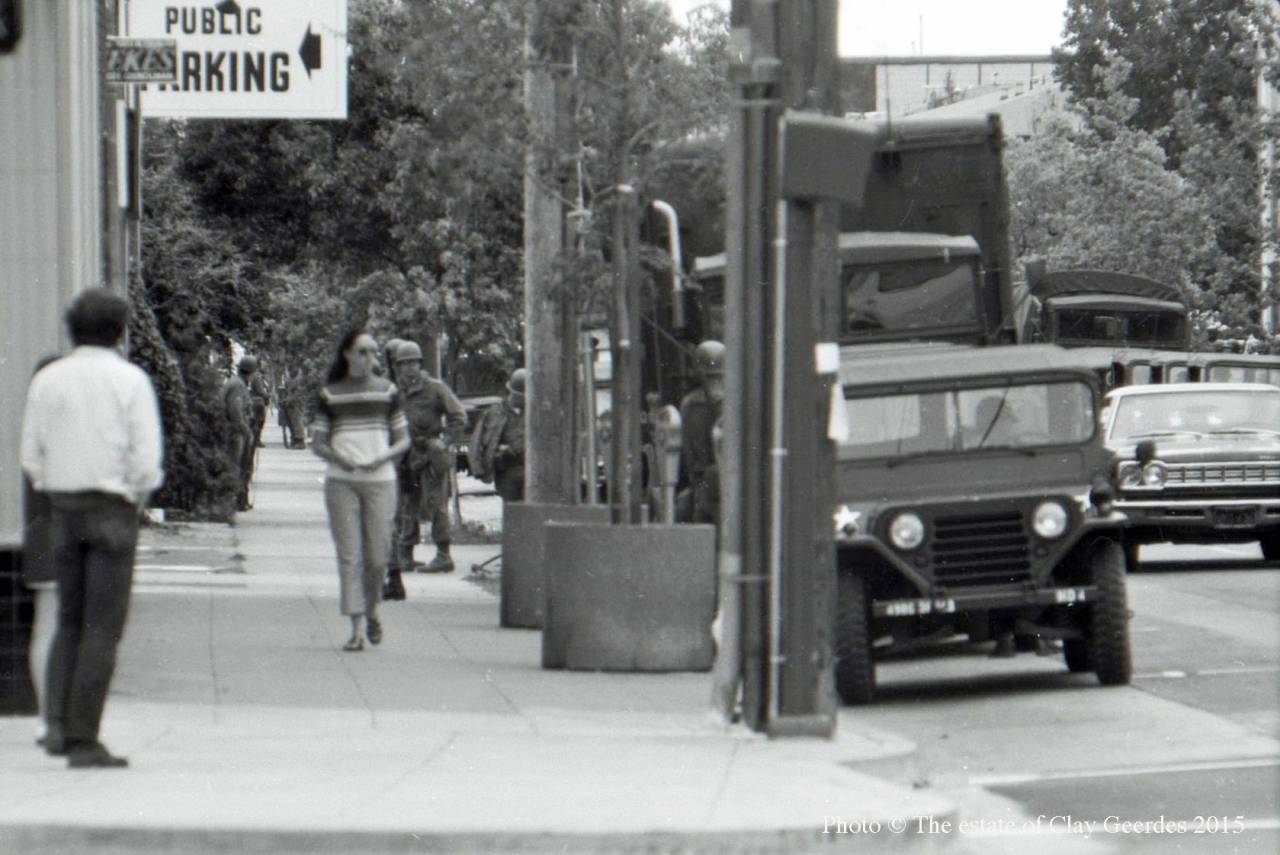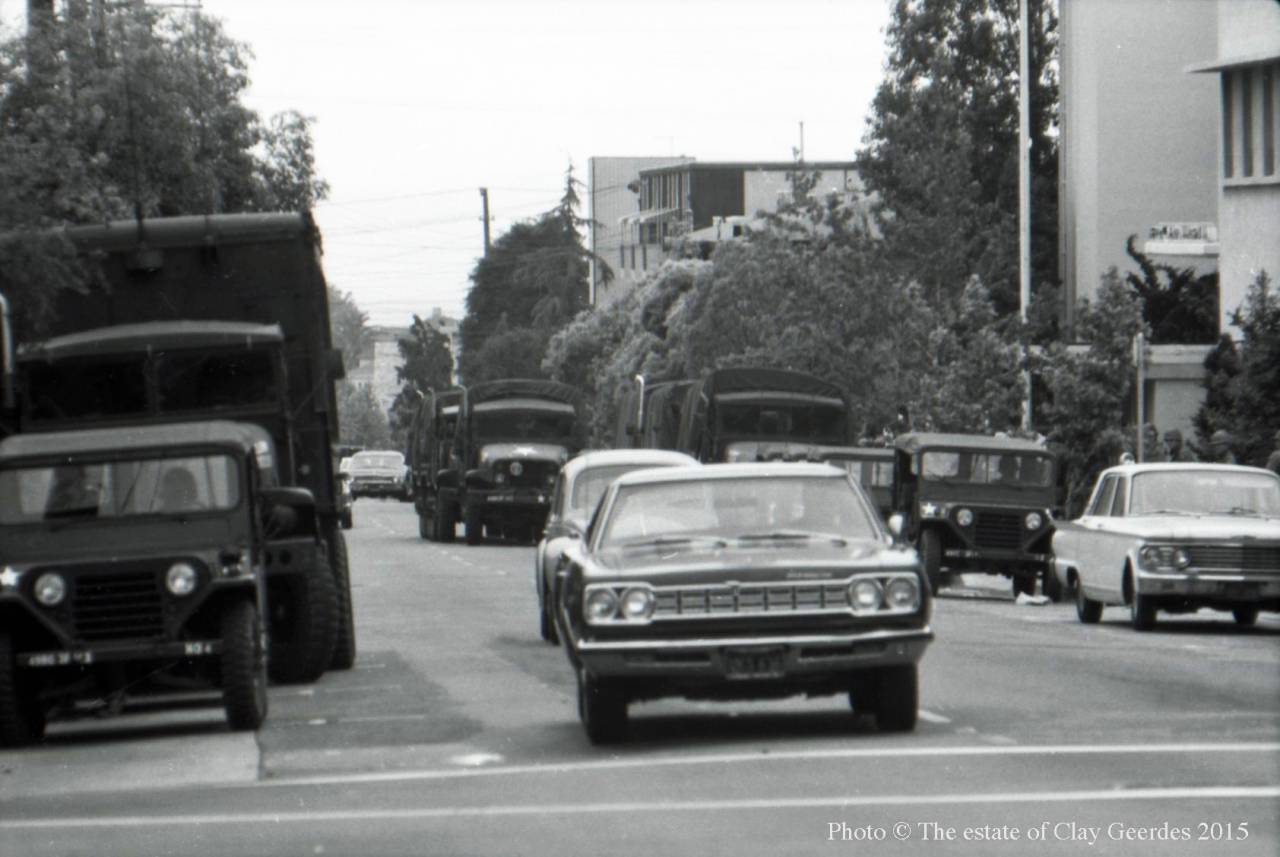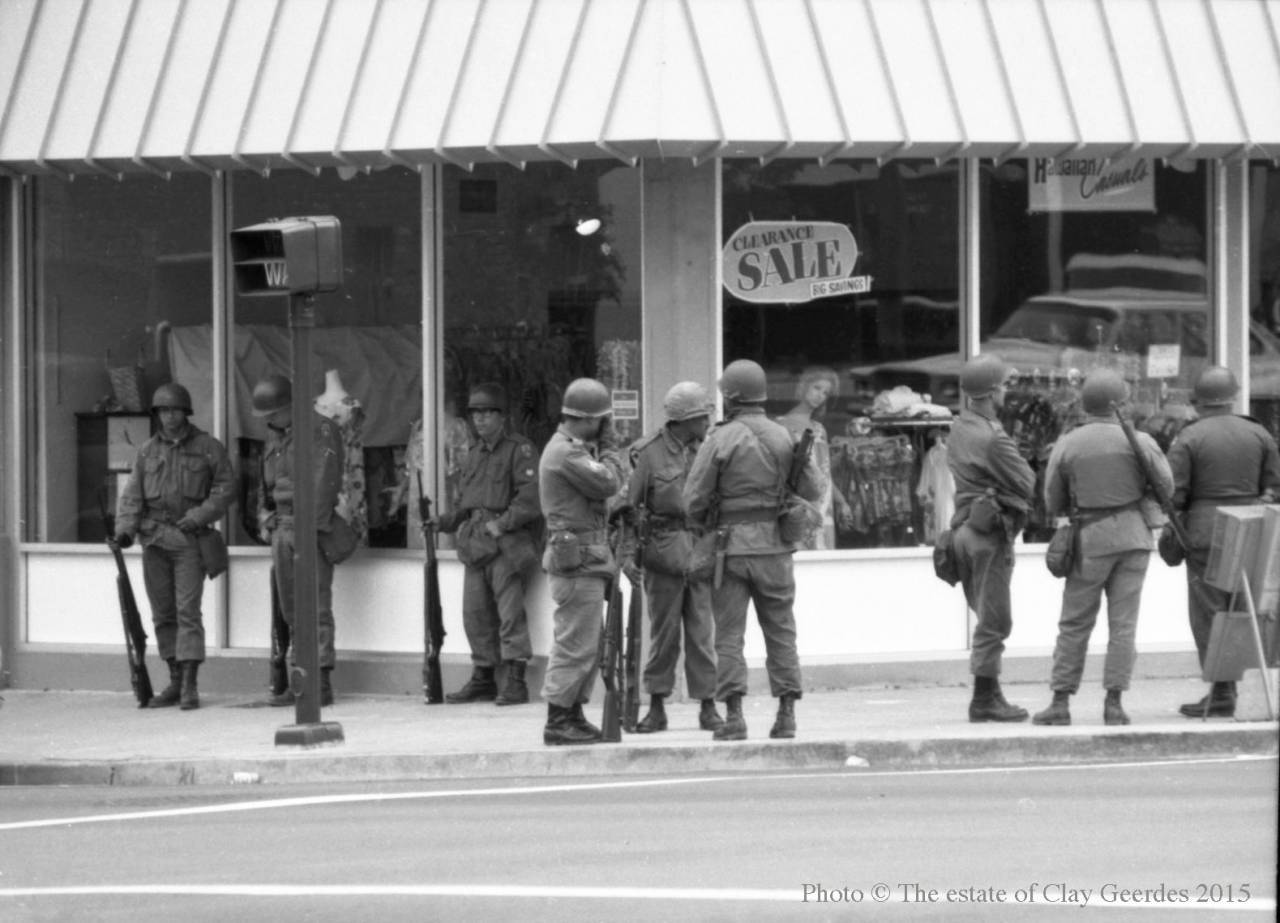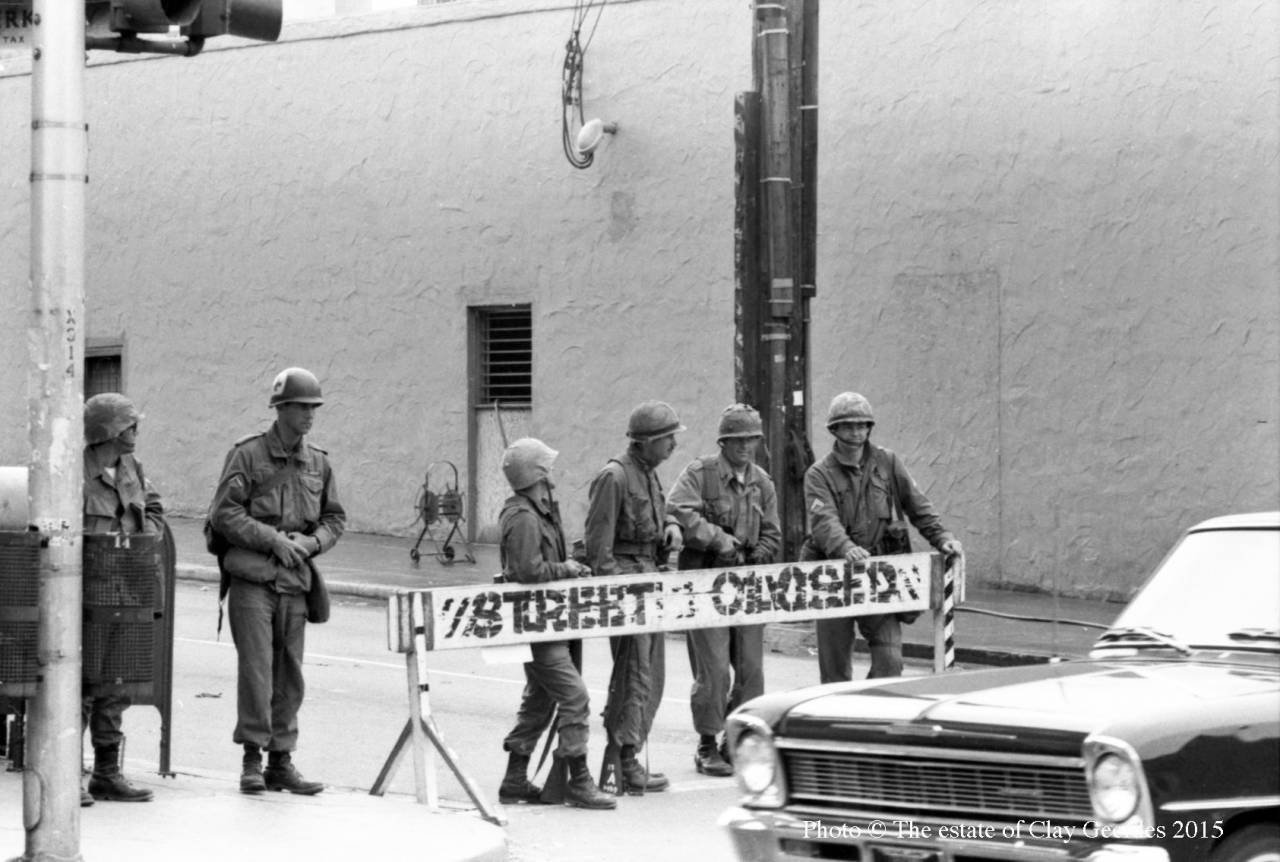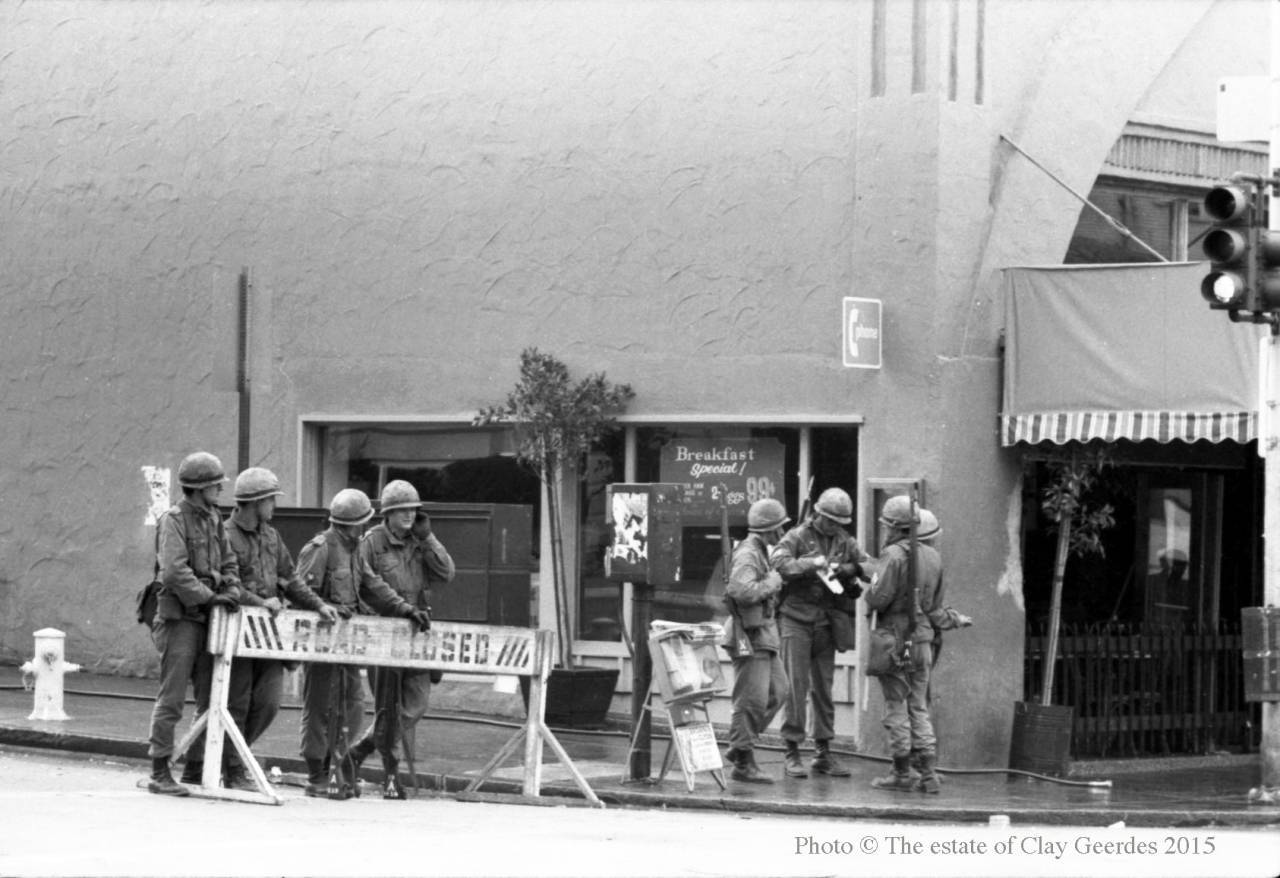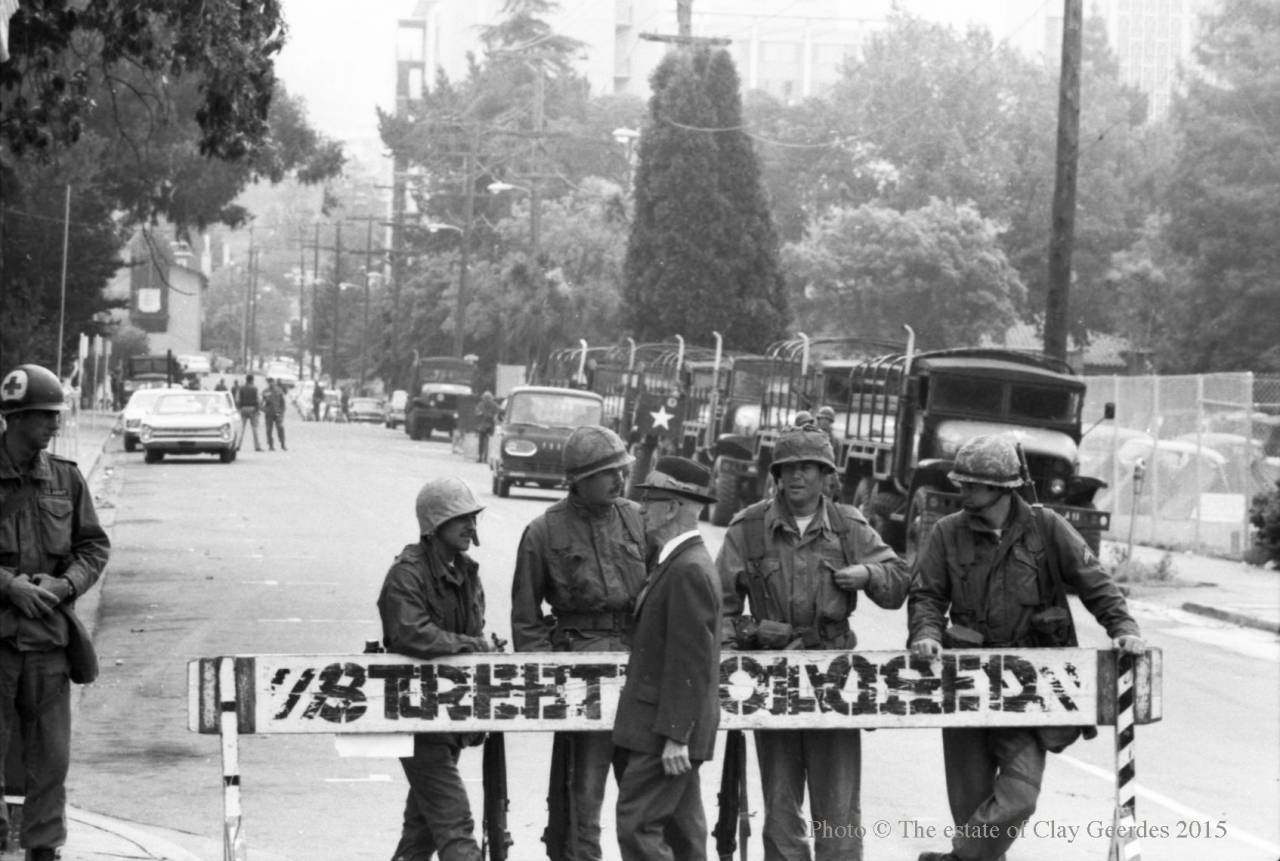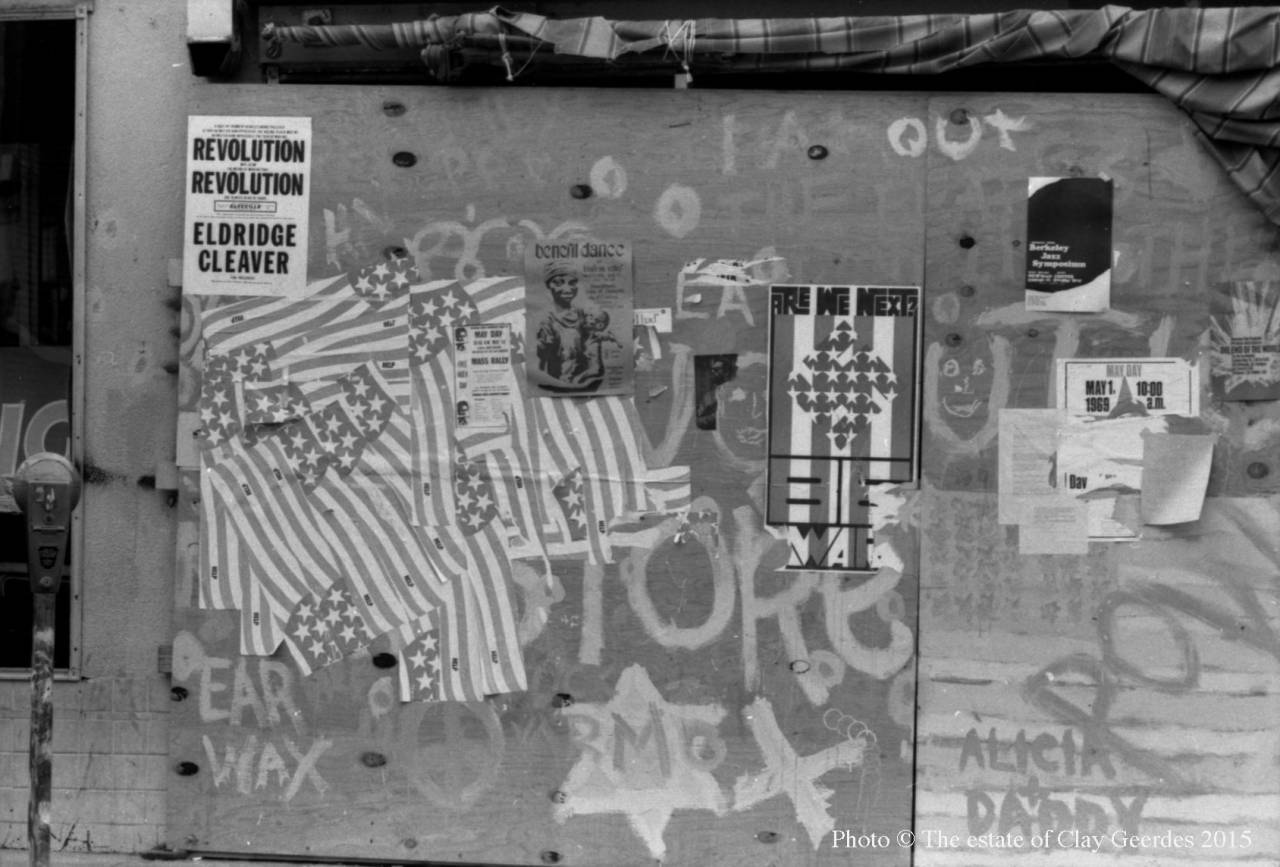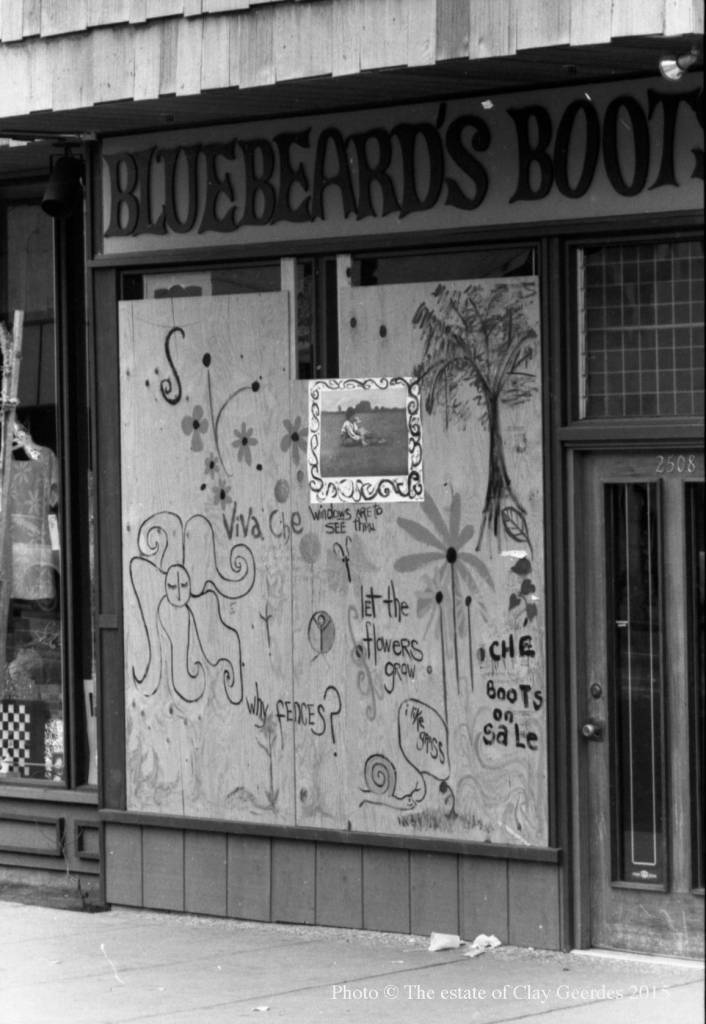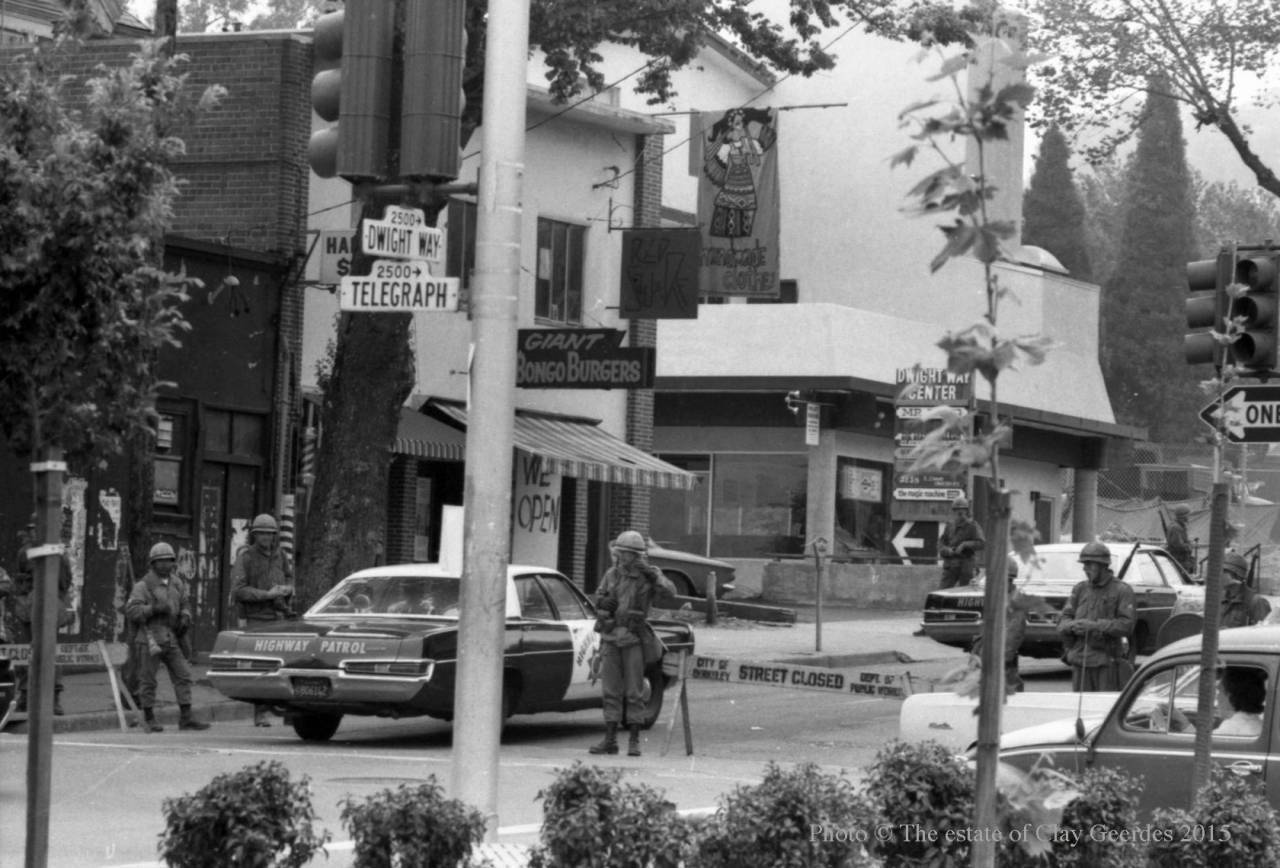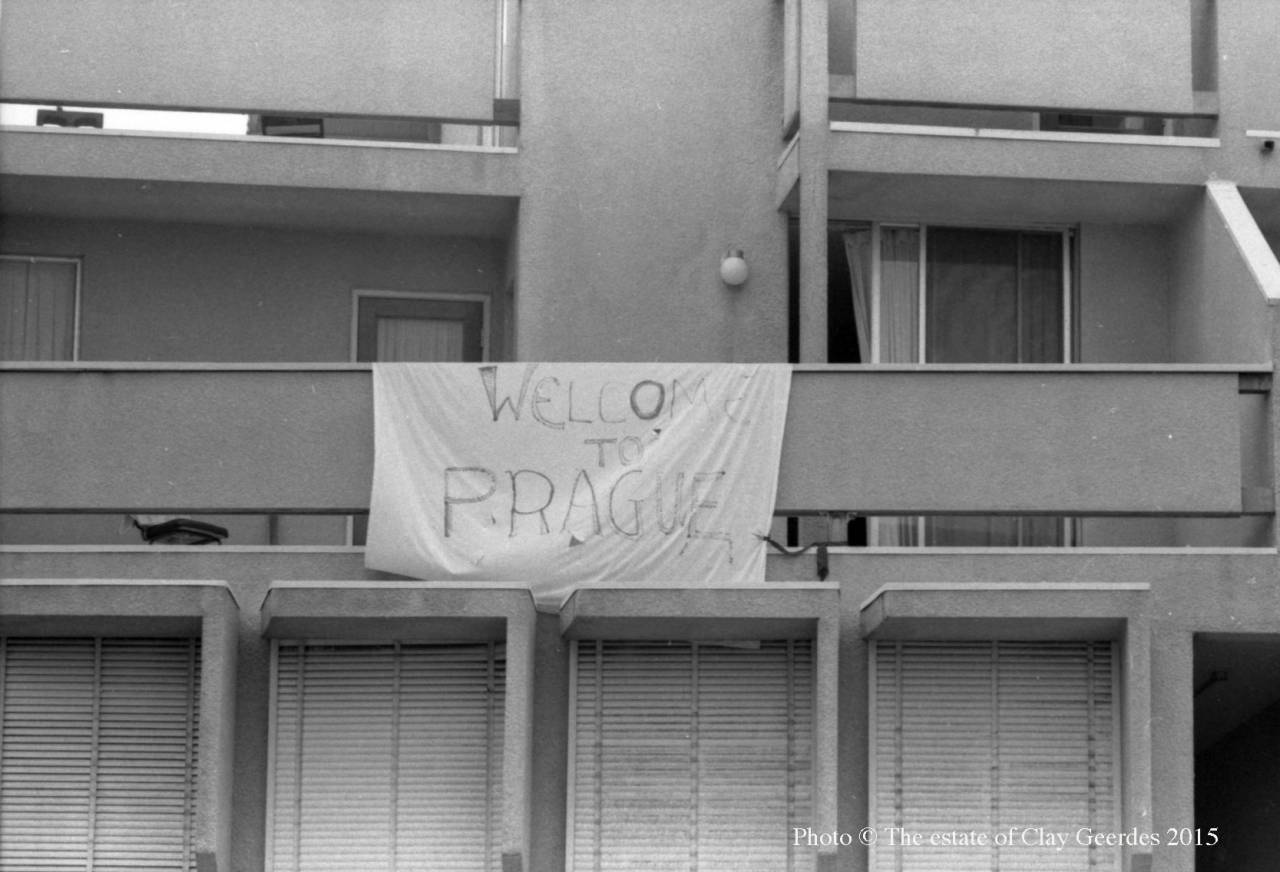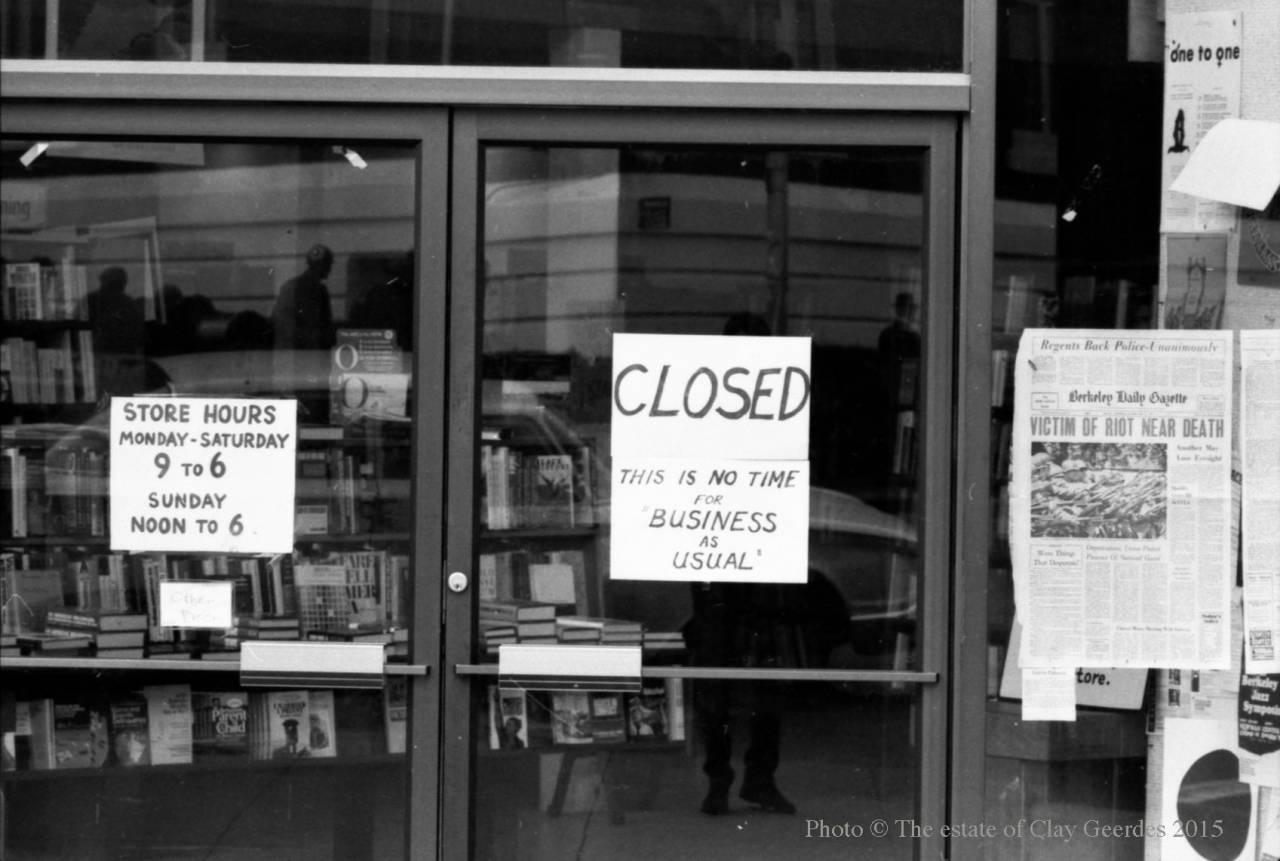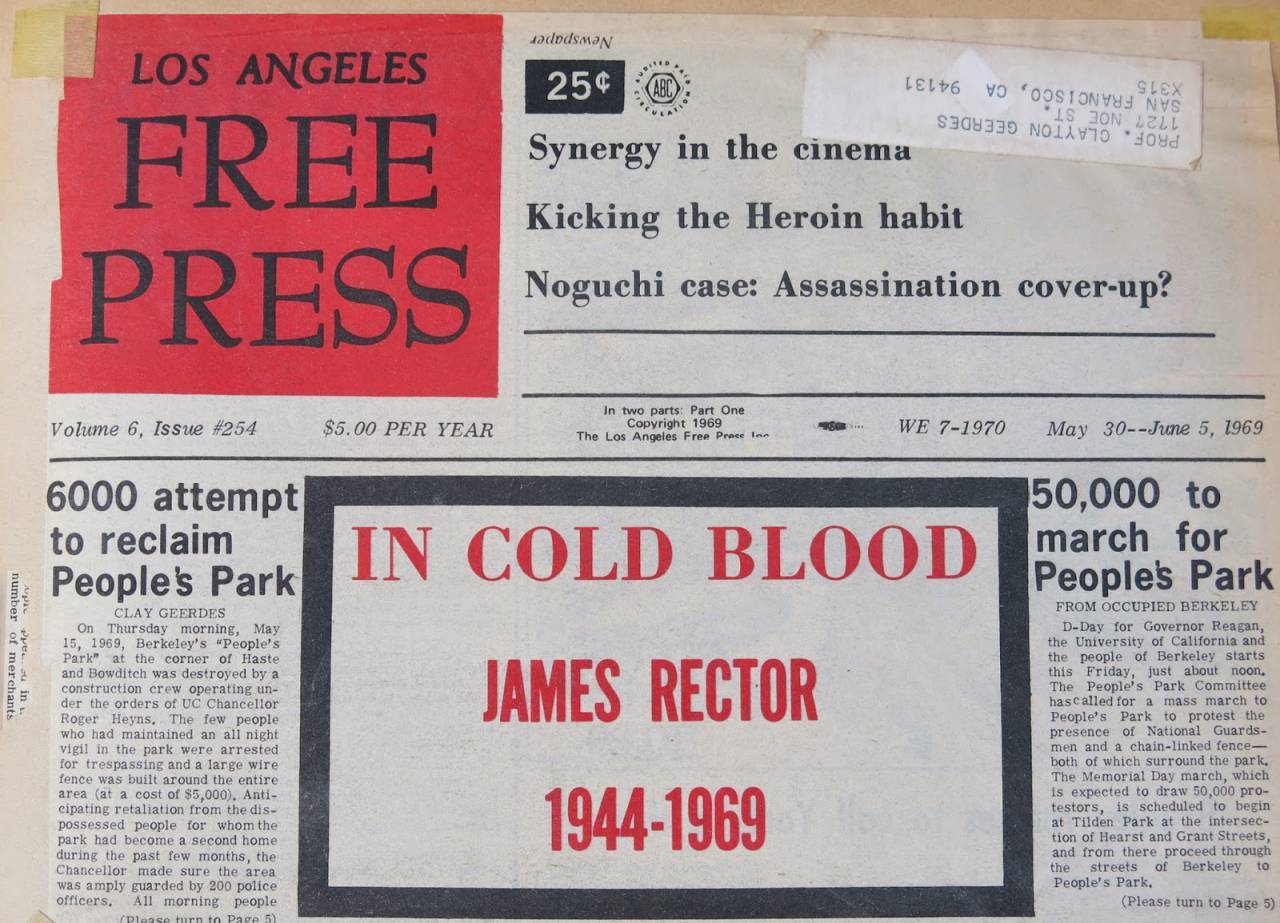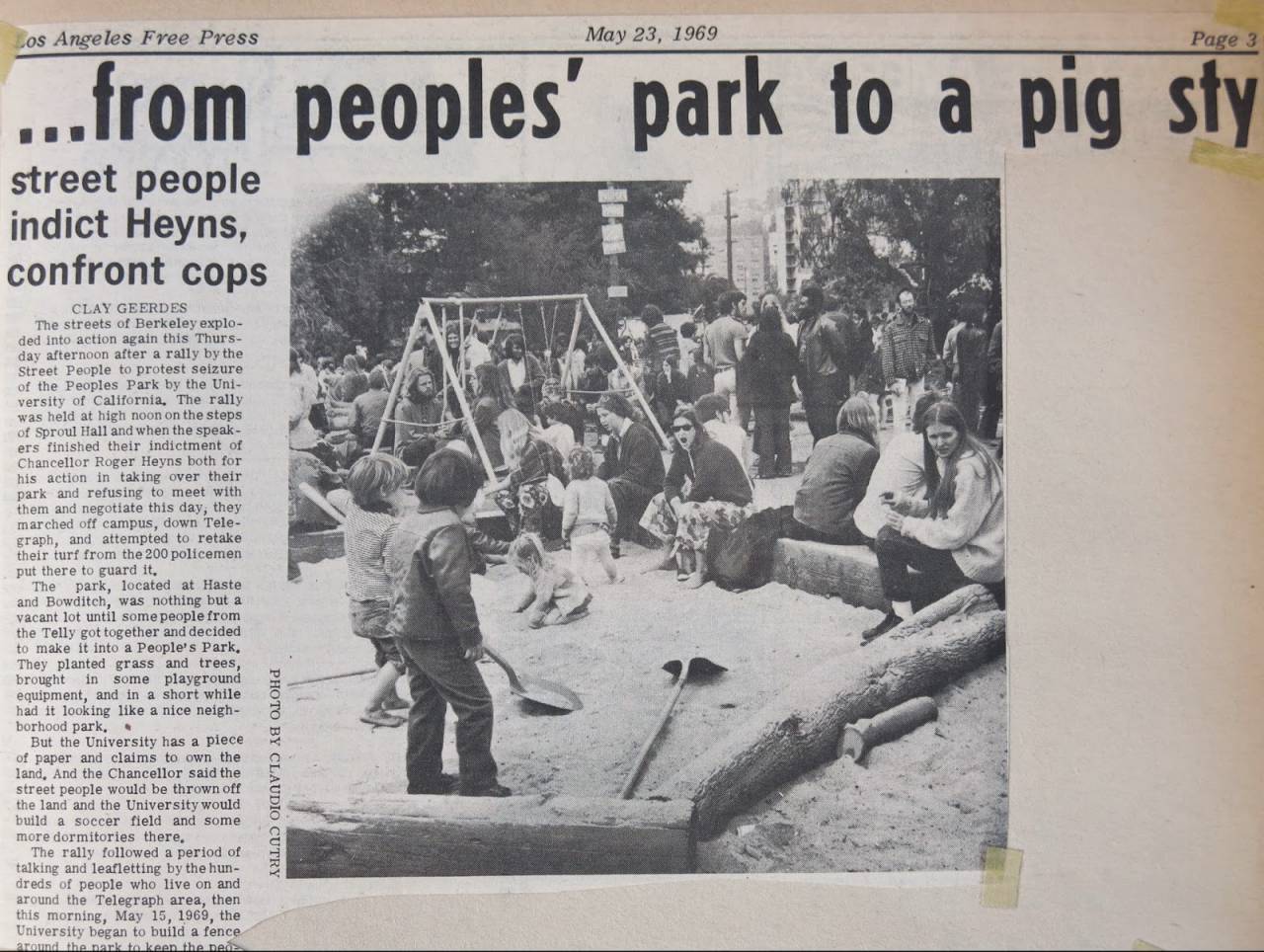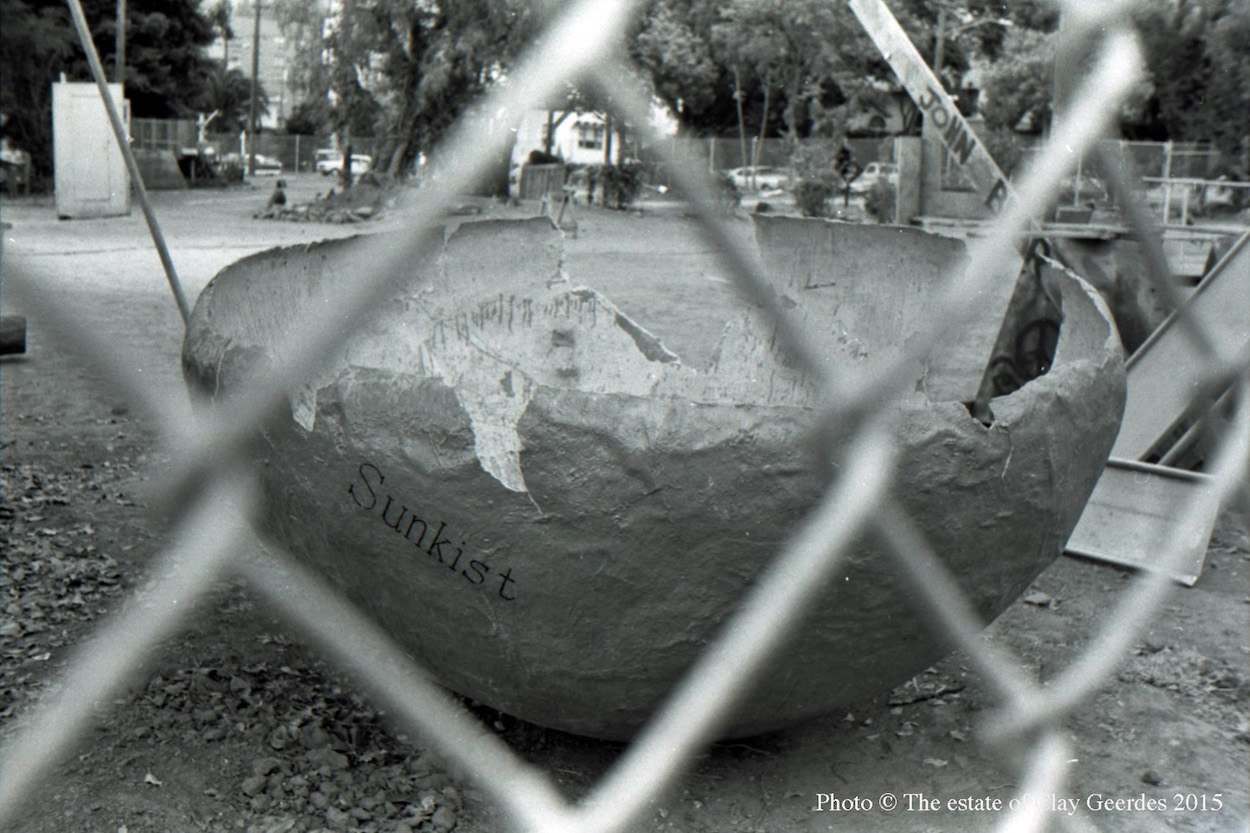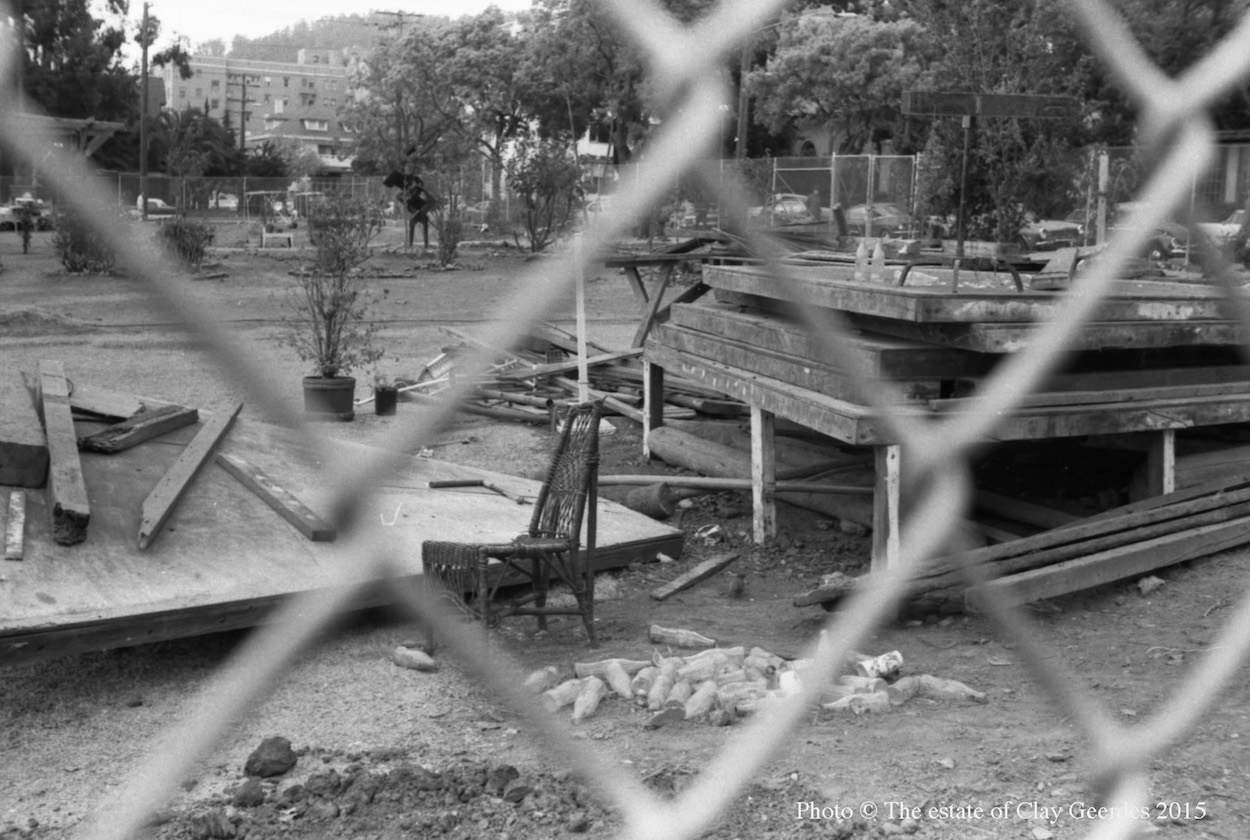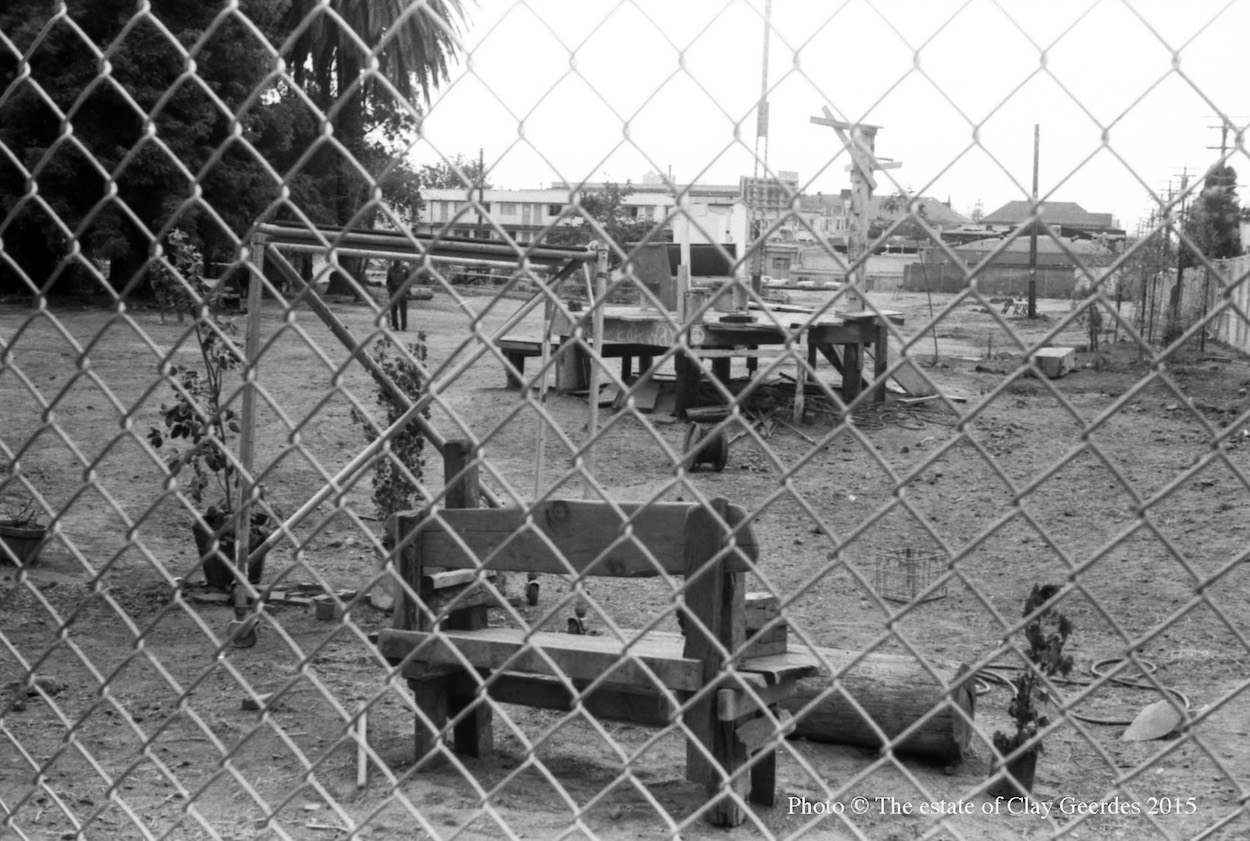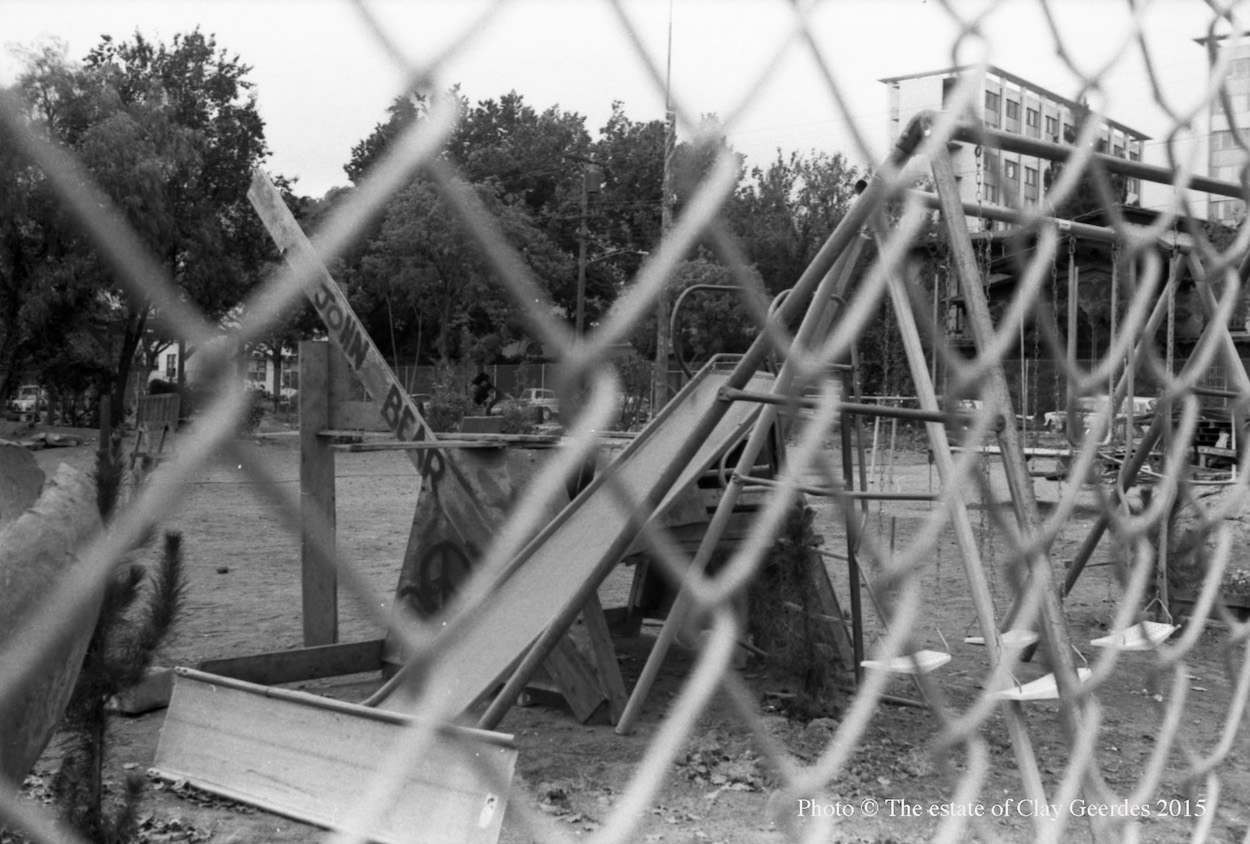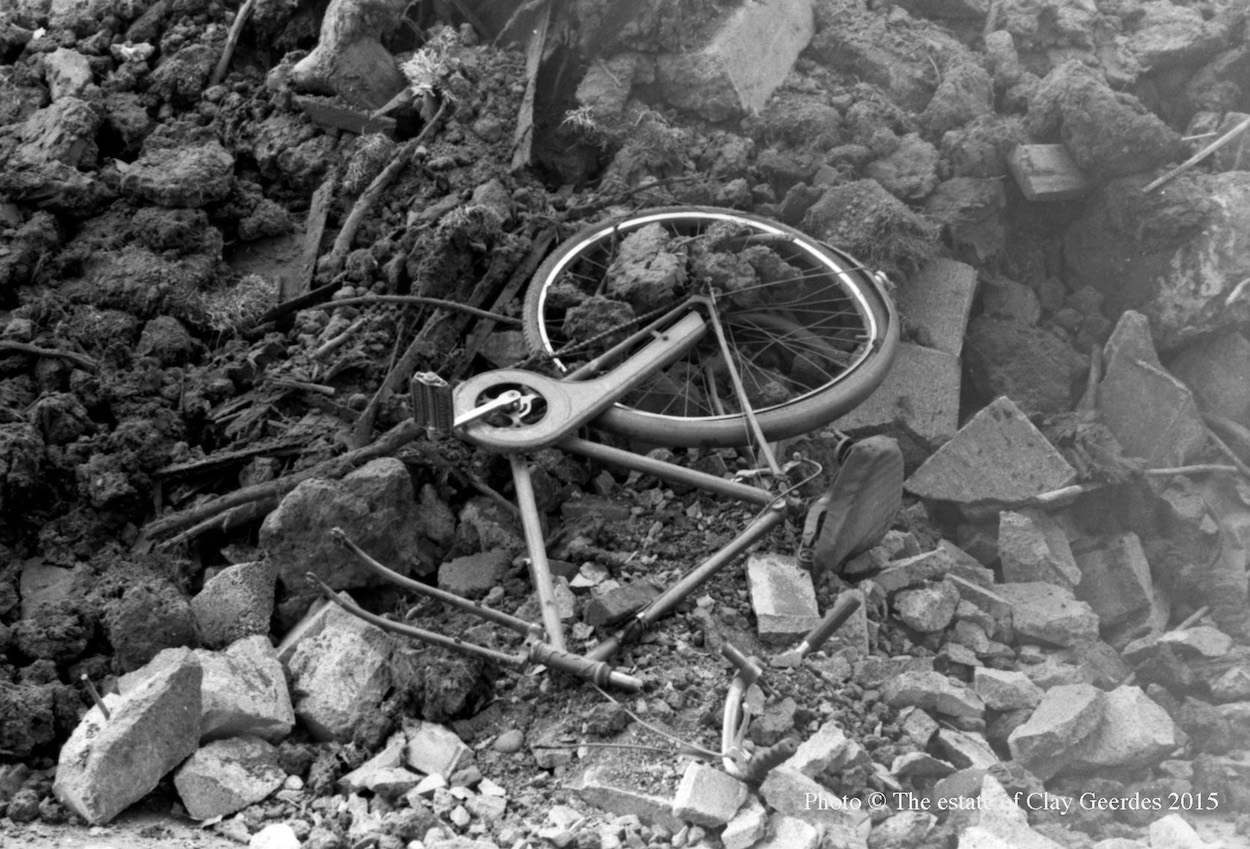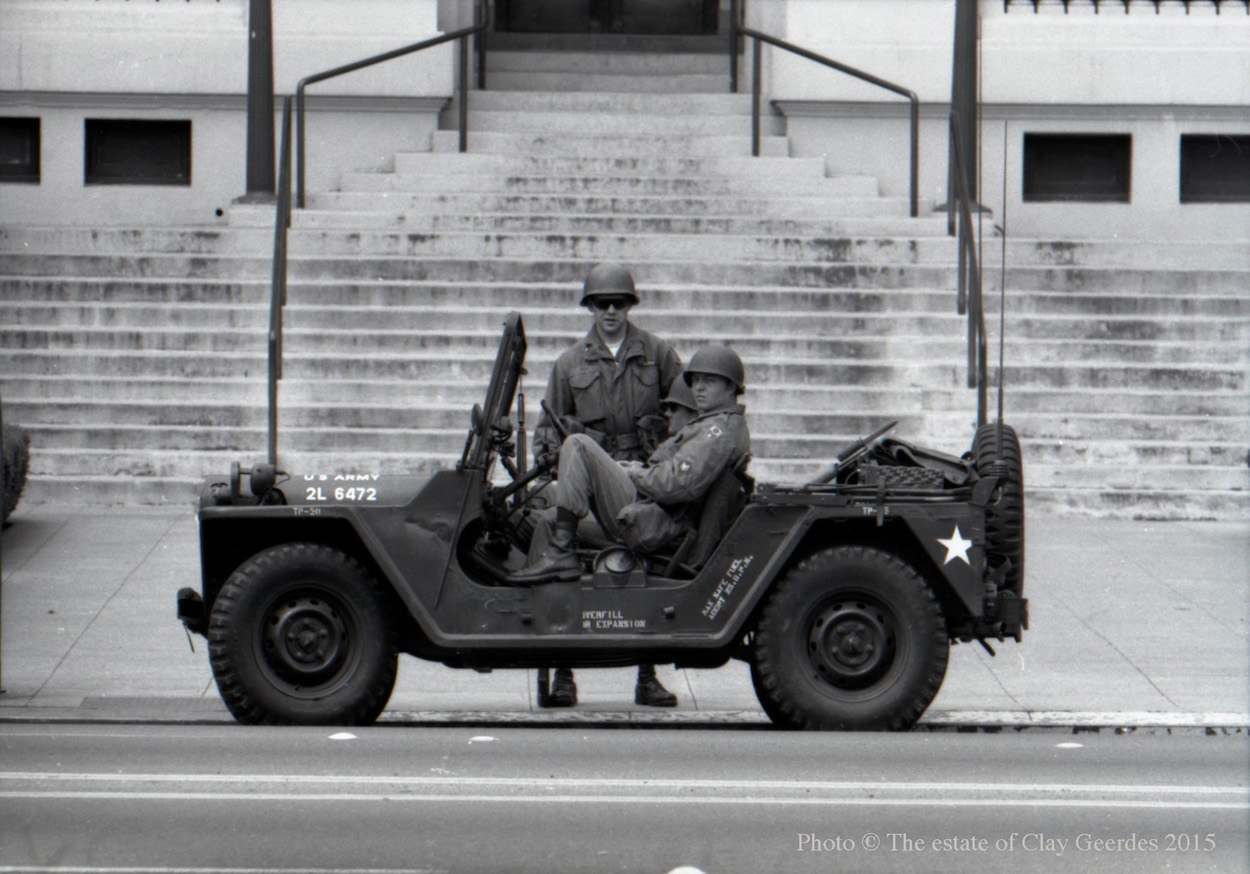Clay Geerdes was a photographer, journalist, publisher and an artist in underground comics. In 1969, Clay took these photographs of The People’s Park at Berkeley, California.
Clay’s close friend David Miller tells us:
Born in Nebraska in 1934, Clay enlisted in the Navy in 1954. Out of the service, he studied at San Francisco State College, majoring in English. After college he joined the staff of Fresno State College as an English professor in 1965. It was during his time at FSC that he saw beat poets and authors like Allen Ginsberg, Richard Brautigan, and William Saroyon, and became interested in becoming a writer himself. He kept an apartment in the Haight district of San Francisco and commuted back and forth during this time and watched the “Hippie movement” growing in San Francisco. The conservative attitudes at FSC led to his leaving that position to take up freelance photo-journalism. His first published piece was for the L.A. Free Press, which led to other offers at the Berkeley Barb, Village Voice, SF Ball, SF Phoenix and various other papers and magazines such as Adam and High Times.
He was an obsessive writer and photographer and moved between conventional and alternative culture, chronicling it as he went along.
Thanks to Clay’s talent for spotting and recording a story, and his keen-eye for the detail and technique, we get to see these pictures from a time when radicals wanted change for society, before the therapeutic sensibility dulled the senses and encouraged ‘journeys’ into the self and a better world through mindfulness and the narcissism of self discovery.
Michael Morton now tells the story of The People’s Park:
When remembering the unsteady combination of casual tumult and imaginative principles that defined the history of the Bay Area during the late 1960s and early 1970s, a particular degree of interest should be accorded to the patch of soil in Berkeley that became known as The People’s Park. It was there, beginning in April, 1969, that one of the most famous (and, unfortunately, one of the most violent) conflicts between the freethinking counterculture and the inflexible authorities happened, pitting a stoutly determined alliance of students, hippies, and activists against the narrow-minded power of Governor Ronald Reagan, the Board of Regents of the University of California, and the National Guard.
Clay Geerdes was on the streets of Berkeley when People’s Park happened, observing the actions on both sides and, as usual, taking photographs. Looking back, years later, he offered this description of the general situation.
Clay Geerdes: When People’s Park took place in Berkeley, in April of 1969, it wasn’t the beginning of anything. It was the climax of many things that had been happening for the past couple of years. A lot of local people participated in landscaping that empty lot Between Haste Street and Dwight Way. UC had left it a trash-filled mudhole and had not kept it up at all. In a few days, it was cleaned up by hundreds of people, many of them neighbors who lived along the street, then UC sneaked in during the early hours of the morning on May 15, put up a cyclone fence, and had the place guarded by Alameda County Tac Squad cops who laughed at the people who lived around the park, as they pulled up the trees and stomped on the flower beds. This type of insensitive, anti-community, asshole behavior triggered one of Berkeley’s largest riots as thousands of students and local people attacked and tore down the fence to reclaim the park and get some satisfaction.
Well, it was short-lived, because you can’t fight fire with gasoline. Sheriff Frank Madigan armed his cops with shotguns and they started shooting people. Over a hundred people were treated at Highland and other local hospitals for shotgun pellet wounds and one student, James Rector, was killed when he was shot by a passing deputy. It was the Vietnam War come home. Governor Ronald Reagan was willing to destroy Berkeley in order to save it. He had a couple of divisions of paratroopers on standby down at Fort Ord, and he declared a state of emergency in Berkeley, sending in the National Guard. The army drove up and down Durant and Dana and Haste and Bowditch and other Berkeley streets, spraying pepper fog at us.
A helicopter tear-gassed students having lunch on the terrace of the Commons, then did a sweep of Strawberry Canyon, dumping the rest of the load on people who were swimming and playing tennis in the area. On its run, the helicopter made sure to get the kids playing in the yard at Willard School. The next day I read in one of the straight papers, probably the San Francisco Chronicle, that police were reacting to having rocks and bottles thrown at them when they started firing rock salt from their shotguns. I always had to smile at that “objective” reporting.
The following extracts are taken from articles that Clay Geerdes wrote about the conflict in Berkeley, giving his firsthand account of what happened on the streets, published in the Los Angeles Free Press, late May and early June, 1969.
Clay Geerdes: The streets of Berkeley exploded into action again this Thursday afternoon after a rally by the street people to protest seizure of the People’s Park by the University of California. The rally was held at high noon on the steps of Sproul Hall and when the speakers finished their indictment of Chancellor Roger Heyns both for his action in taking over their park and refusing to meet with them and negotiate this day, they marched off campus, down Telegraph, and attempted to retake their turf from the 200 policemen put there to guard it.
The park, located at Haste and Bowditch, was nothing but a vacant lot until some people from the Telly got together and decide to make it into a People’s Park. They planted grass and trees, brought in some playground equipment, and in a short while had it looking like a nice neighborhood park.
But the University has a piece of paper and claims to own the land, and the Chancellor said the street people would be thrown off the land and the University would build a soccer field and some more dormitories there.
The rally followed a period of talking and leafleting by the hundreds of people who live on and around the Telegraph area, then this morning, May 15, 1969, the University began to build a fence around the park to keep the people out.
Declarations of war appeared in the Berkeley Barb and Good Times. A rally was called and a few thousand people turned out this afternoon to take to the streets and fight the police.
After the rally, there was a march down to the park and the large crowd rushed the police, trying to break through into the park. When the police found they would be unable to control the crowd, they began to tear-gas them. Soon the streets in and around Telegraph were filled with the acrid odor of tear gas and there were dozens of people running up and down Durant, Haste, and Dana. An unmarked police care was overturned and burned, the black smoke mixing with the gray tear gas in the air. The warriors were young, many of them in their early teens. The police shot five of them with a shotgun near the park and the battle was on.
Sirens. The wounded were being taken away. The people held the intersection at Telegraph and Durant until police drove them out with dozens of tear gas canisters. A few young girls hurried down Durant holding wet napkins against the lower parts of their faces. Everyone had tears in their eyes. The intersections were all busy and two National Guard jeeps arrived at Durant at 2:30. They circled the intersection and then swept the street, gassing everyone and everything in sight. Their jeeps were met with rocks and flying Coke bottles. They were called all of the appropriate names by those who ran from the steady stream of grey gas that poured out of their jeeps.
This reporter was wiped out for a few moments by the gas and can testify that it definitely does contain some kind of skin irritant. When I could see again, the police, still in their masks, were chasing people across the public parking lot situated between Durant and an adjacent street. They caught one young man and wailed on him with their clubs. He disappeared behind a wall of cars and gas. Another young man in a red serape sped past me and escaped the Man’s club.
Friday morning found National Guard troops bivouacked in the small park on Haste and Bowditch, the park which triggered a no-holds-barred street war on Thursday afternoon. The fighting continued late into the night with the last major battle occurring on the UC campus in the Sproul Plaza where hundreds of pro-park people rained stones and bottles and everything else they found loose onto the heads of occupying police forces. A ten o’clock curfew is now in effect.
The Guardsmen are not as uptight as the Alameda County Sheriff and his deputies. They occupy the intersections of the Telegraph area. People photograph them. They watch. Many smile.
Stories and rumors. Members of SDS are leafleting this morning, calling for a rally on the campus in spite of Reagan’s rule against rallies and sound equipment. The banner on their leaflet reads: STOP POLICE TERROR. A rumor is going around that two or three people have been killed. No way to confirm the rumor. Another rumor has a girl blinded by buckshot. It is a fact that the San Francisco Tactical Squad was bussed into Berkeley shortly after two yesterday afternoon (in regular buses, can you dig it?) and it is a fact that they fired shotguns. San Francisco Chief of Police Thomas Cahill told KQED newspeople that his department had issued no shotguns. He did not find out about his men using shotguns until nearly 24 hours later.
A young man who was working down on the 2200 block of Telegraph Avenue on Thursday afternoon told me a rather gruesome story about Willard Junior High School. Seems the Berkeley Tac Squad was afraid that the young students would hurry up and join the street fighting on the Telegraph so they padlocked the schoolyard and surrounded it (the school has one of those protective institutional 6-foot wire fences all around the playground). Not satisfied with this precaution, they proceeded to tear-gas all the kids inside the fence.
The next photographs show the “occupation” of downtown Berkeley that ensued after a state of emergency was declared by Governor Ronald Reagan.
Clay Geerdes: Thousands of people marched to UC’s campanile on Friday morning in protest against the Police and Military State now being imposed upon the large number of citizens who live and work in the Berkeley streets. The march was led by a young man carrying a long pole from which waved a bloody shirt. The shirt was raised by the campanile and a meeting was held. The crowd was asked not to attack the National Guard. The people were not in agreement on tactics. Many chanted: “TAKE THE PARK NOW! WE WANT THE PARK!” Bob Mandel of the Oakland 7 told the people: “Walk the streets, talk… stop shopping in downtown Berkeley.” A massive march to City Hall followed the speeches and the people found their elected officials missing and the building guarded by the National Guard (complete with fixed bayonets). A Park Committee has been trying to get in touch with Roger Heyns (UC Chancellor) to negotiate, but he is out of town. It is clear from his actions that he does not intend to negotiate anyway.
Patience is relative to age and the young people here in Berkeley have run out. Many are upset at this point that they are still playing the same street games with protests, marches, and demonstrations when they feel they ought to be doing something more forceful. Thursday night there was much talk of guns and dynamite. What will happen when the voices of ministers and teachers who are maintaining some control over the activities at this time are drowned out by these young revolutionaries who want to “blow that goddam fence up along with the pigs who are standing around in front of it” is anybody’s guess. When police fired shotguns at the kids during Thursday’s street fighting, they escalated the revolution. Those of us who observed the Third World Strike in January and February saw many of these same people move out of the way when the police came toward them. Thursday, they did not move. Instead they hurled pieces of cement, Coke bottles, and variable lengths of pipe taken from construction sites in the Telegraph area. More than this, the young people showed in their tactics a sophistication that was missing before. Many of their number were captured and clubbed in the public parking lot on Durant, but there were, at the end of Thursday’s fighting, a total of 26 police casualties. One saw the roofs of buildings taken by young men who bombarded the occupying police with everything loose. It was this bombardment which provoked a member of the Alameda County Sheriff’s Office to fire his shotgun, wounding four of the young men on the roof with birdshot.
Out there in Merced and Turlock and Fresno and Glendale and Ventura and Ukiah and Eureka and Sacramento are the parents who are paying the taxes that buy the tear gas and shotgun shells to be used against THEIR OWN CHILDREN and one finds it difficult to understand where their feelings have gone. How can they sit in their clubs and their churches and talk about GOD and JESUS and BROTHERLY LOVE and know they are allowing with their votes and their tax money REACTIONARY POLITICIANS to wage a vindictive and cruel war against their children? How can these parents blame their children for a California they have created? In Chicago, Arthur Miller could only shake his head at the people who sat in the Hilton and watched their children shedding their blood in the street below. “They hate their own children,” he said. It appears that he was right and we are seeing in Berkeley simply another example of this hatred in action.
Their main camp is on the site of the People’s Park and the street (Haste) is closed to anyone who does not live in the area. Most of the Guardsmen are relaxed. They are a sharp contrast to the uptight Berkeley police and the Highway Patrol. Governor Ronald Reagan and Frank Madigan and the two police tactical units may believe they are heroically taking a stand against chaos and anarchy in the streets, but the Guardsmen fail to see any Communist Conspiracy in the blue eyes of the young chicks who come up and rap with them on the street corners. So far the Guardsmen are used as a front line defense or offense. They surround things and stand with their bayonets at the ready, but their rifles are not loaded.
Monday morning began with a rally in Sproul Plaza being broken up by gas-masked police. The people dispersed and reformed at the campanile. This rally was broken up by the National Guard. People slipped through the Guard and made their way singly and in small groups to Shattuck Avenue where they set out collectively to close down all business that was being transacted in the area. By this time, doors began to lock automatically whenever young people appeared in the street. A number of merchants hurriedly cleared their shop windows in fear of looting. Others chased people out of their shops and stores for fear they would shoplift during the excitement outside.
During the day, the streets and buildings were spray-painted with canisters. Many of the slogans related to the park, while others related to the occupation of the police and Guard. A sign on Telegraph reads “WELCOME TO PRAGUE.” Cody’s closed and put up a printed sign: “THIS IS NO TIME FOR BUSINESS AS USUAL.”
Below are two examples of Clay’s reports on People’s Park, as they appeared in the Los Angeles Free Press.
People’s Park itself was now forlorn and desolate, surrounded by a chain-link fence and closed to the public.
Clay Geerdes: The afternoon San Francisco Examiner blamed everything on the Communists. All of these children with spray guns and anger are Communists. They are just carrying out good old Mao’s plans, yessiree. Berkeley City Councilman John De Bonis blames it all on immorality. He tells about getting 48 letters from people who live in the neighborhood of People’s Park and all the letters complain about people smoking dope and running naked and all those immoral things. Governor Reagan has said it is okay for the police to shoot down unarmed people if you define them as revolutionaries and anarchists first. Lots of people around assigning blame, but few taking any.
Clay Geerdes died of liver cancer in 1997. For more on Clay’s wonderful legacy visit The Clay Geerdes Archives and Brit Rock by the Bay: INTRODUCTION: THREE FRIENDS.
Would you like to support Flashbak?
Please consider making a donation to our site. We don't want to rely on ads to bring you the best of visual culture. You can also support us by signing up to our Mailing List. And you can also follow us on Facebook, Instagram and Twitter. For great art and culture delivered to your door, visit our shop.
